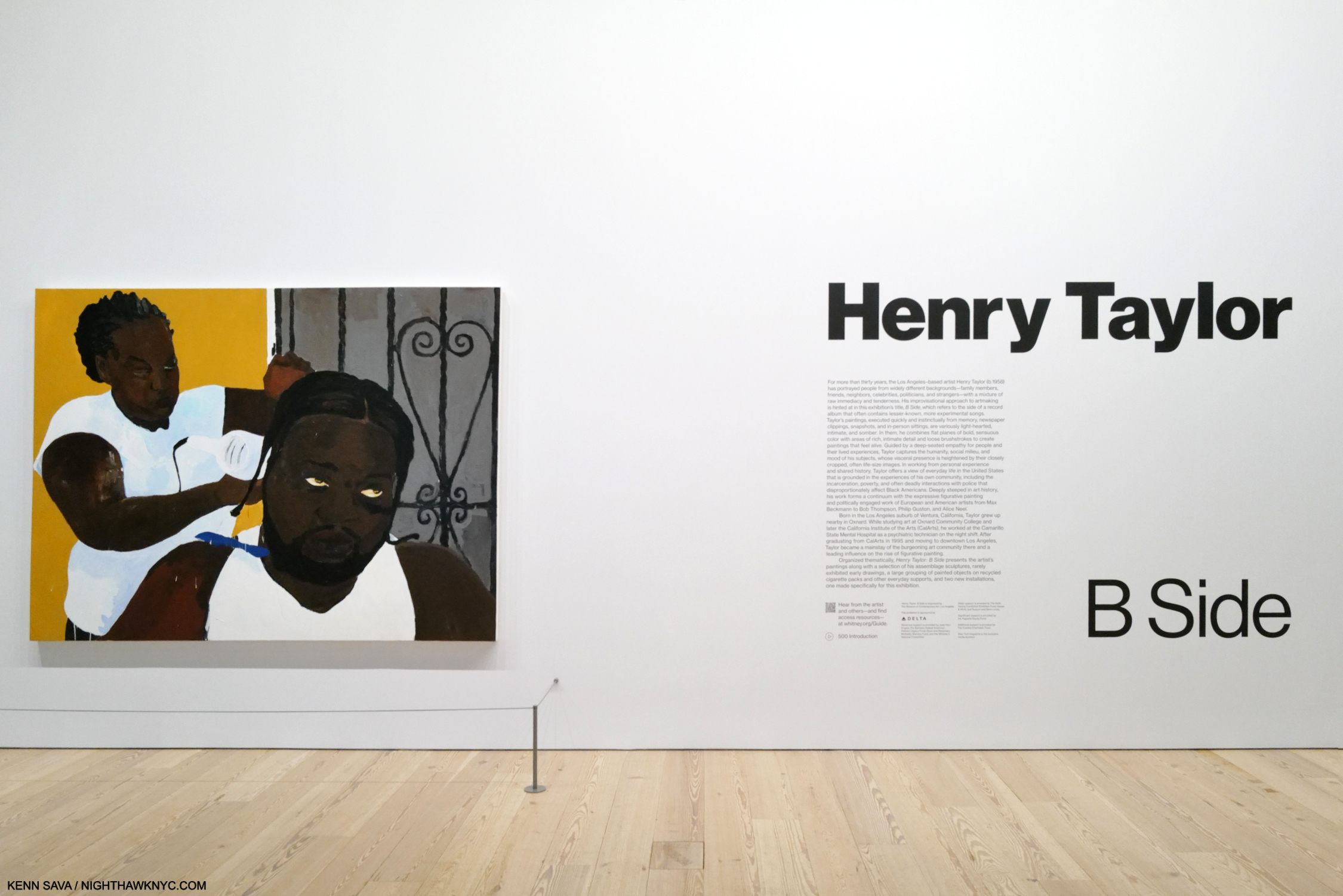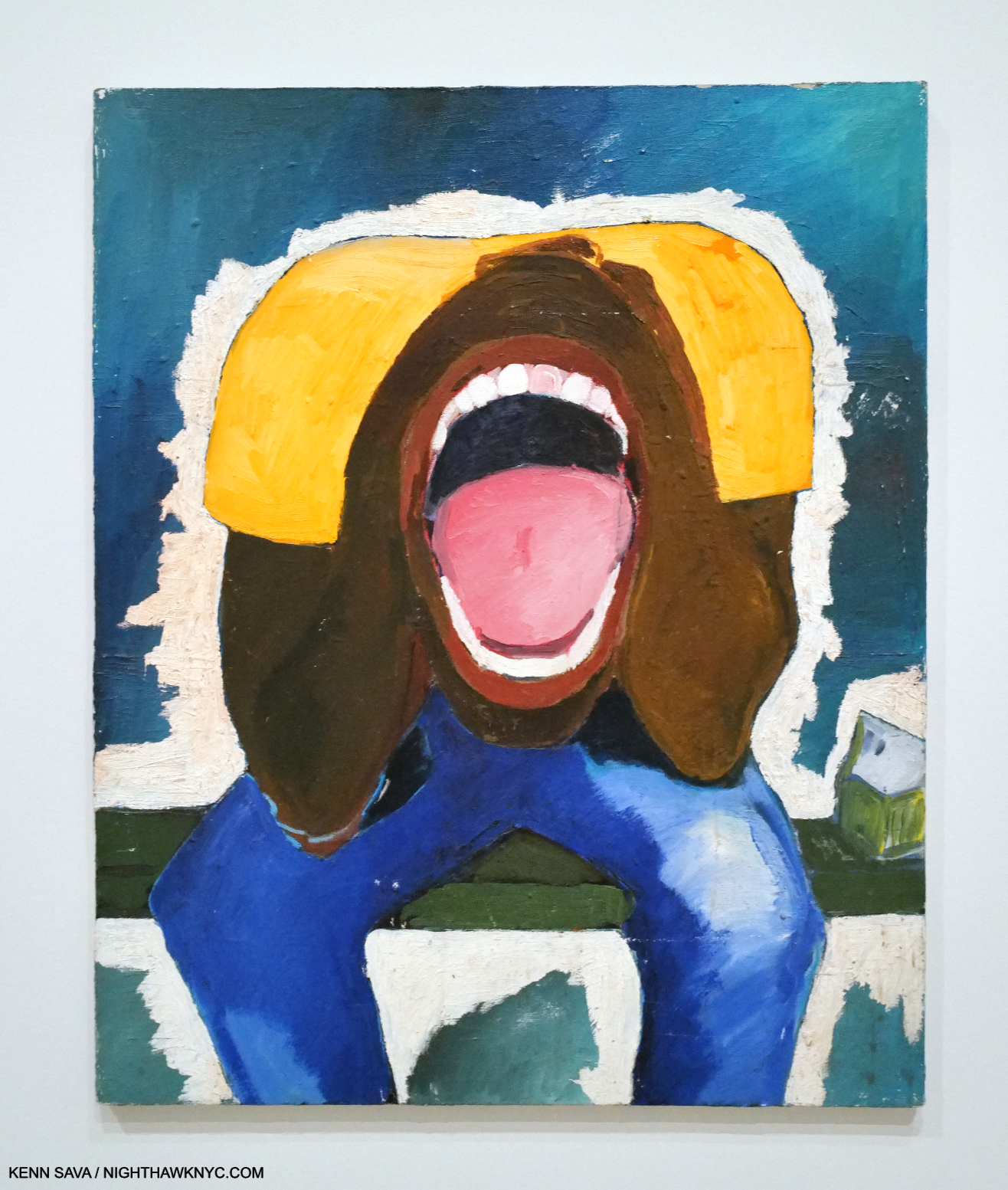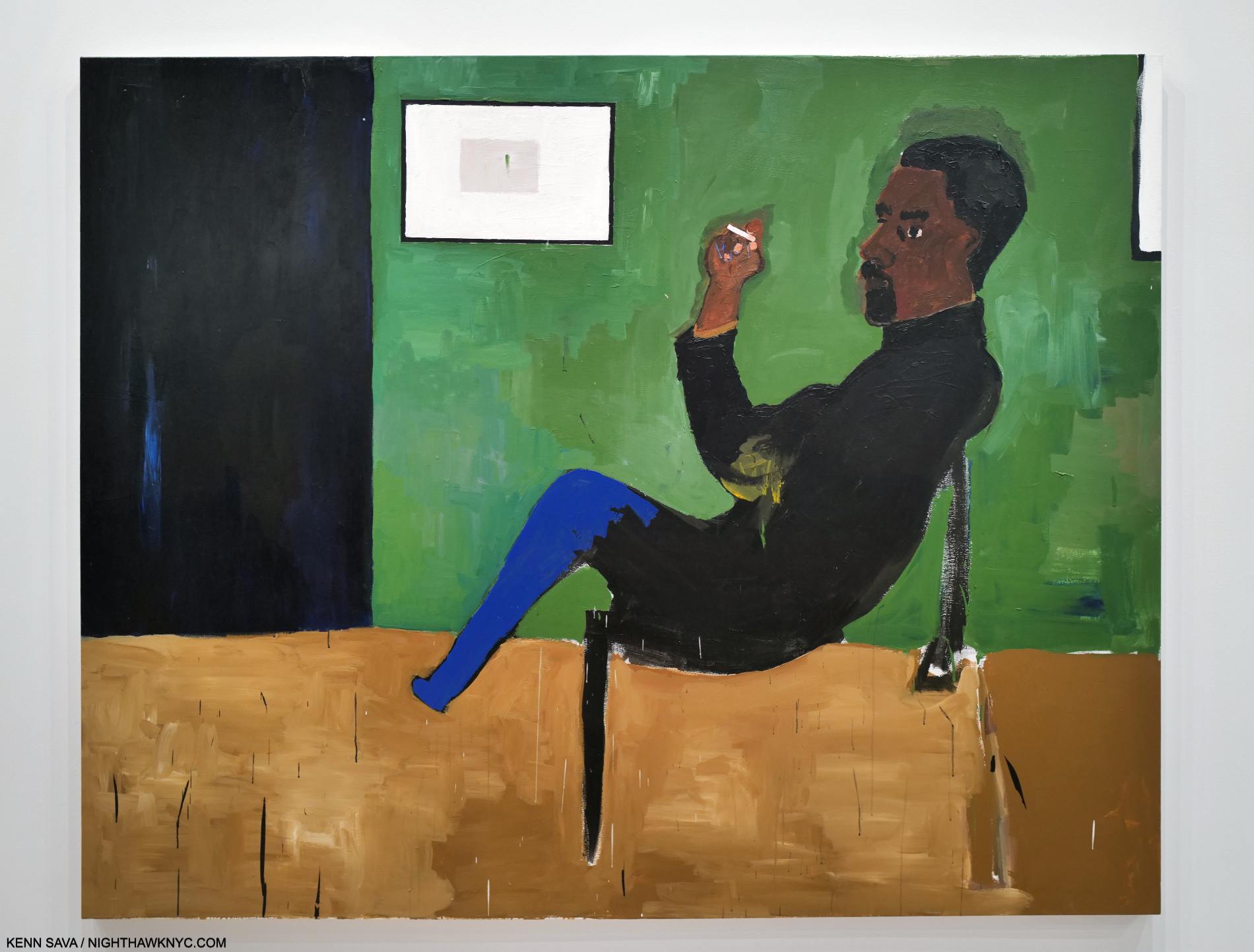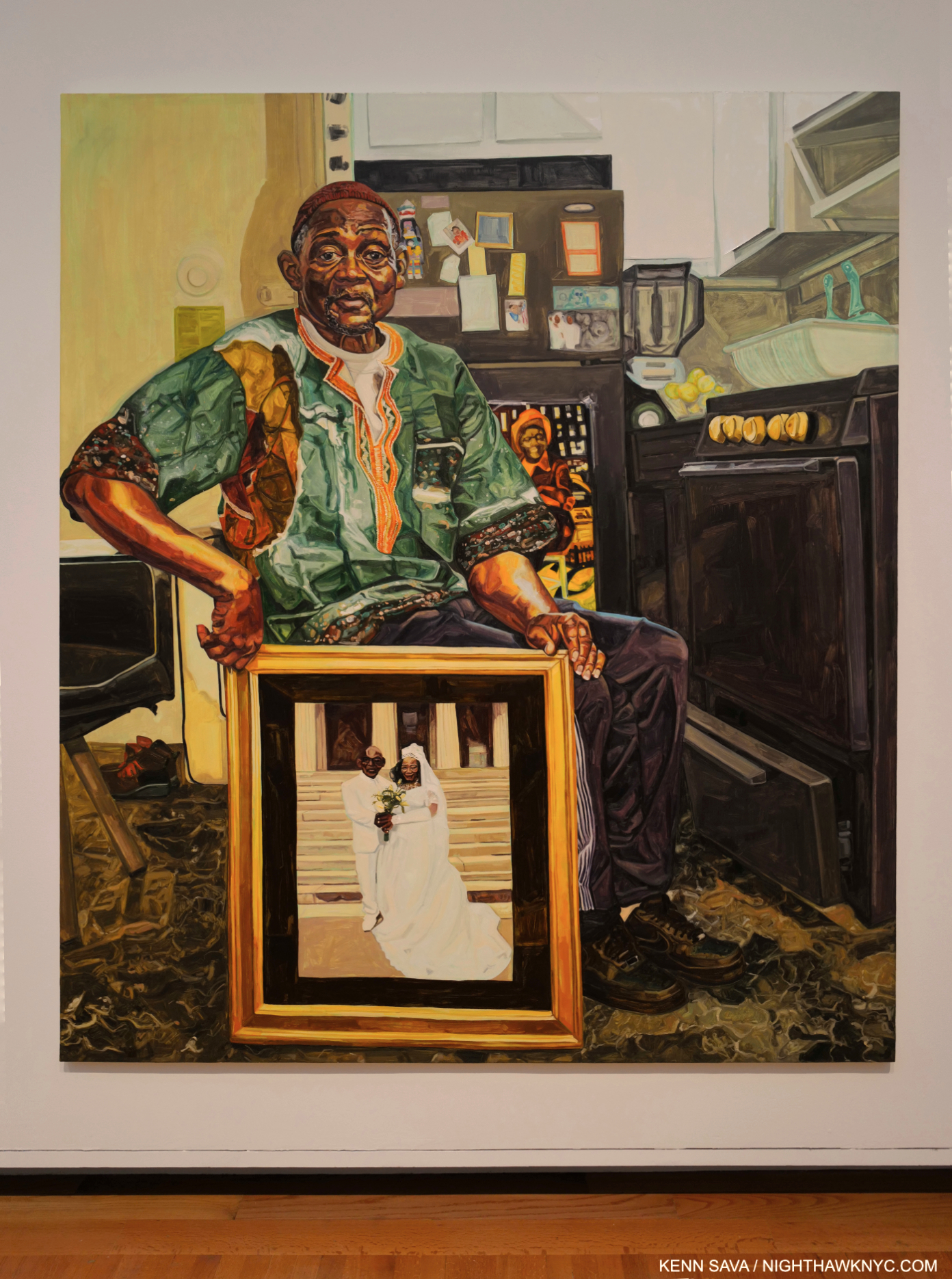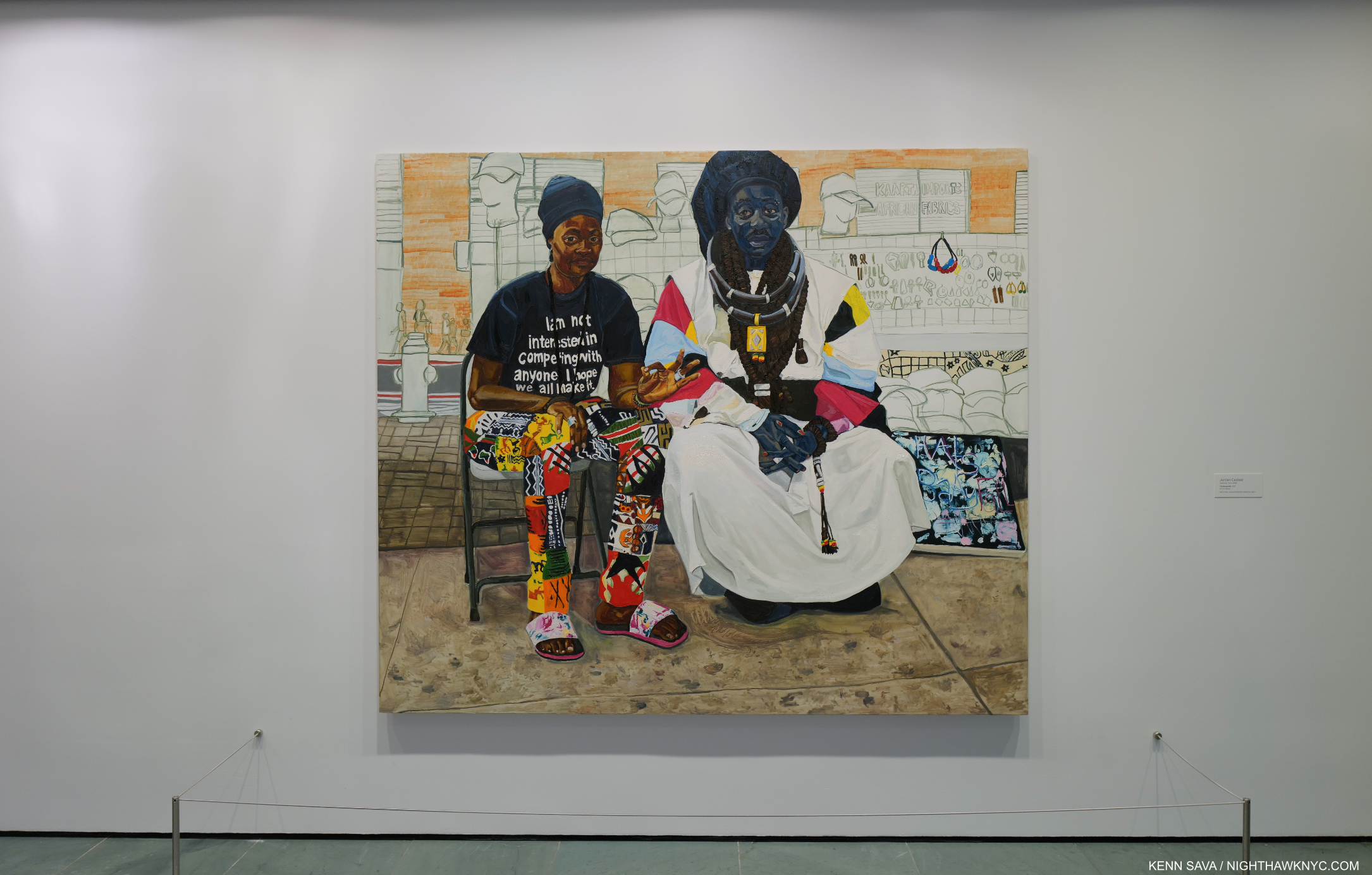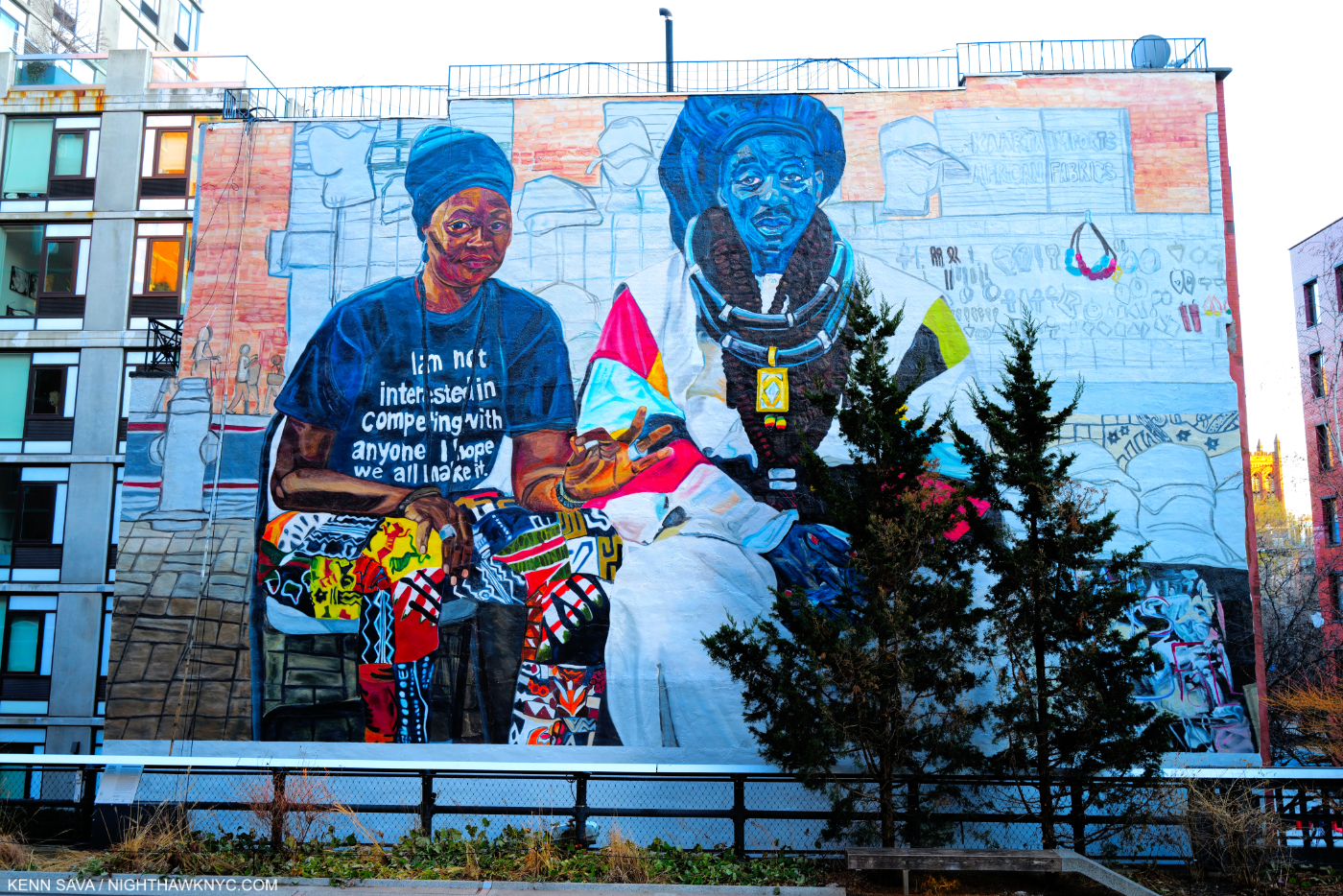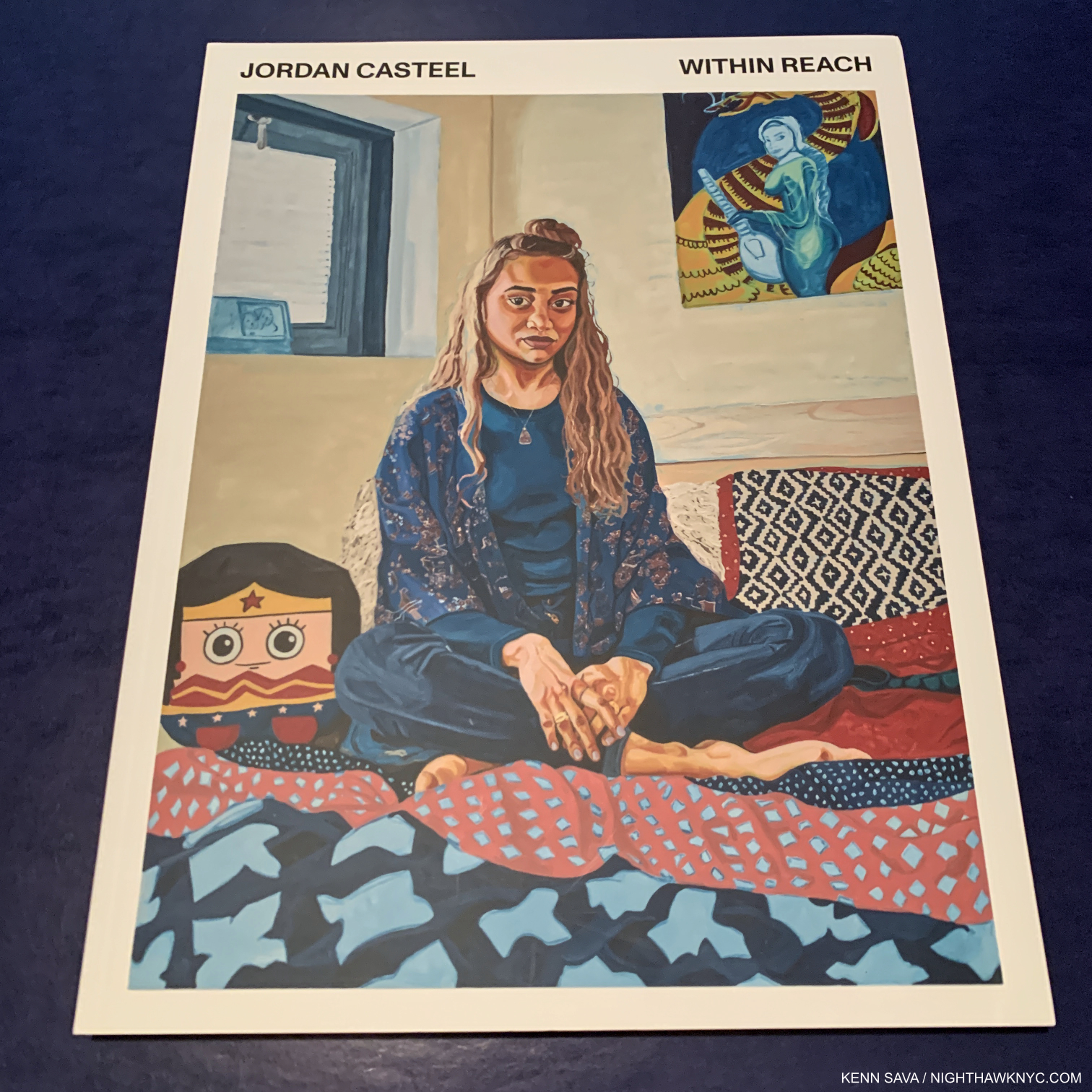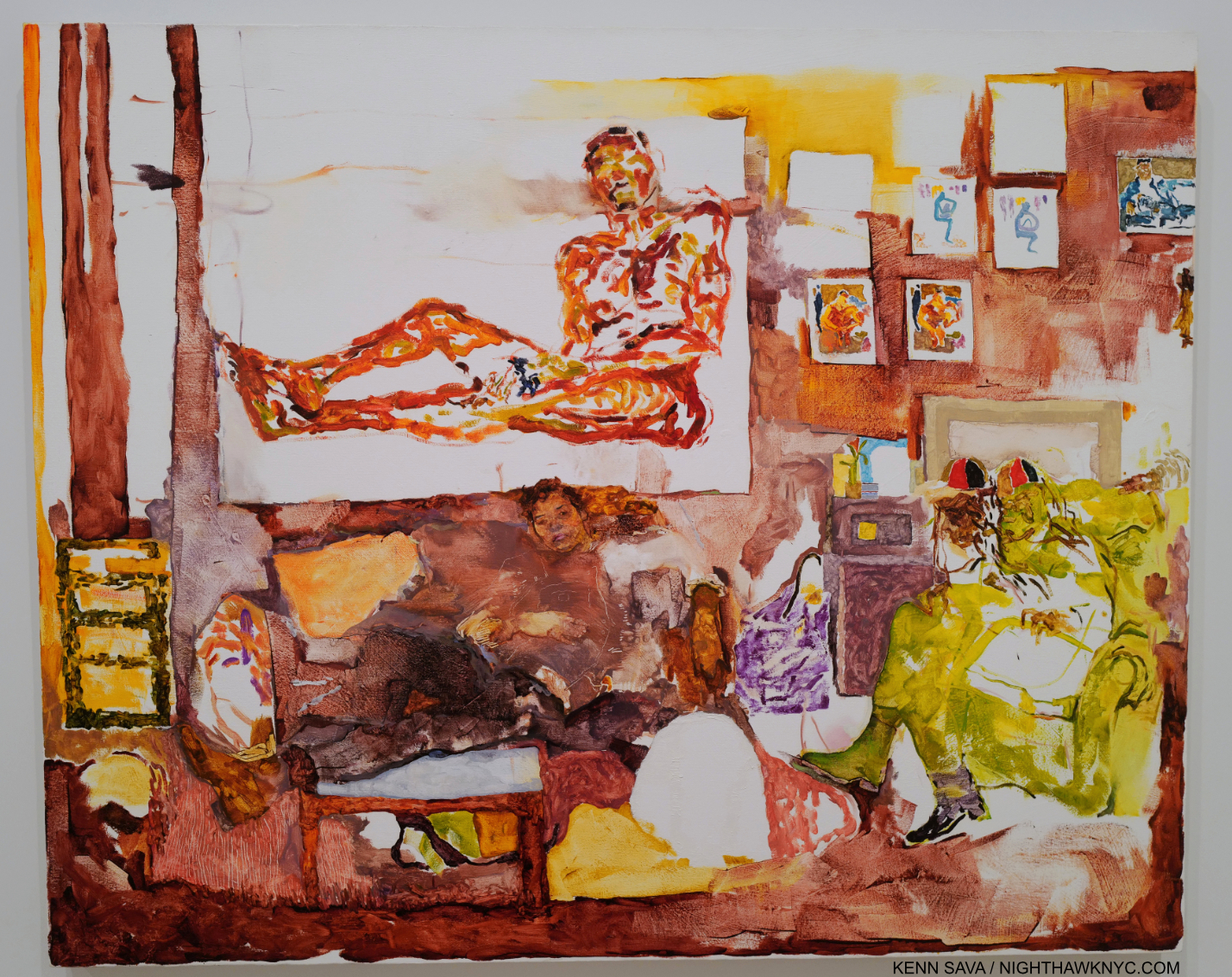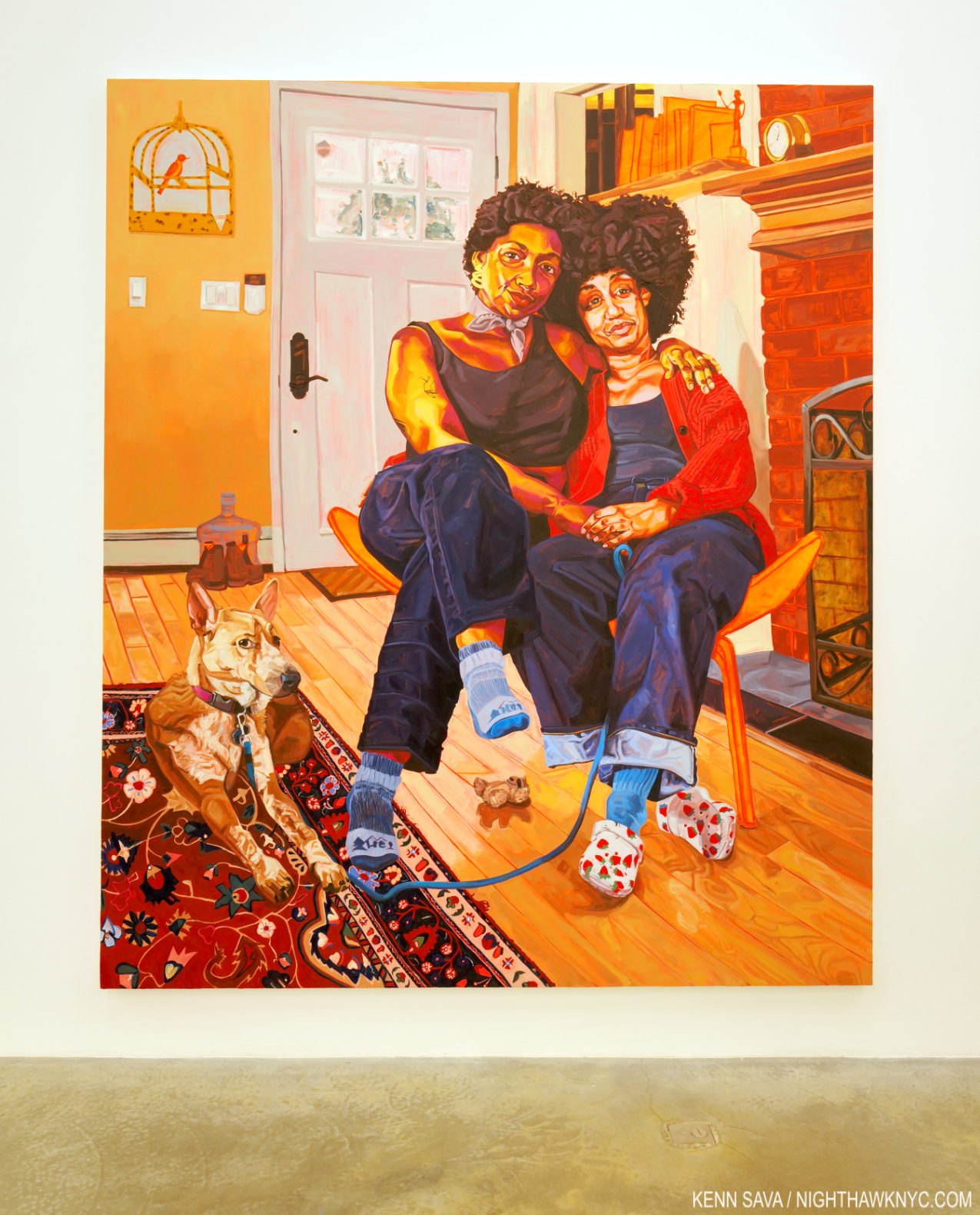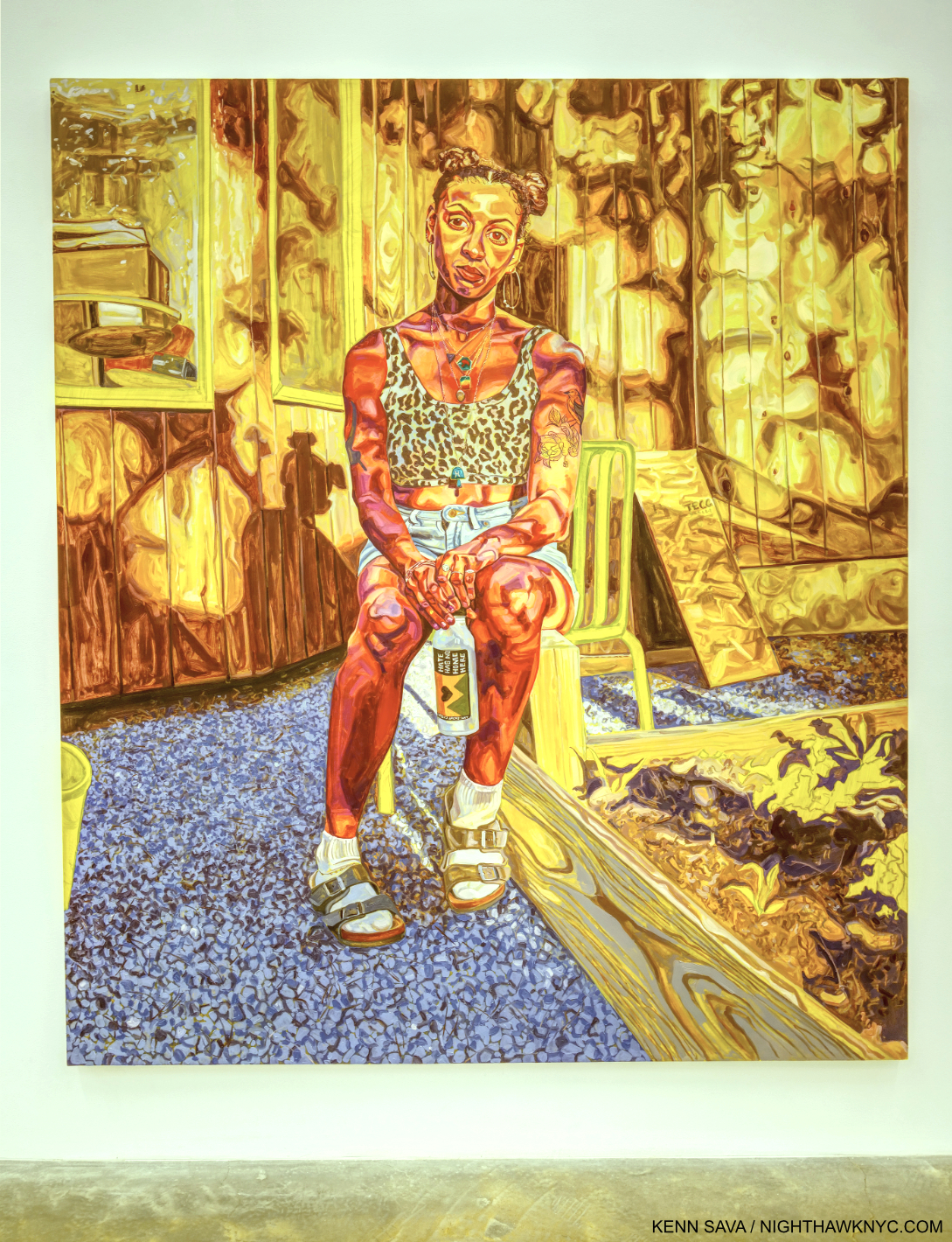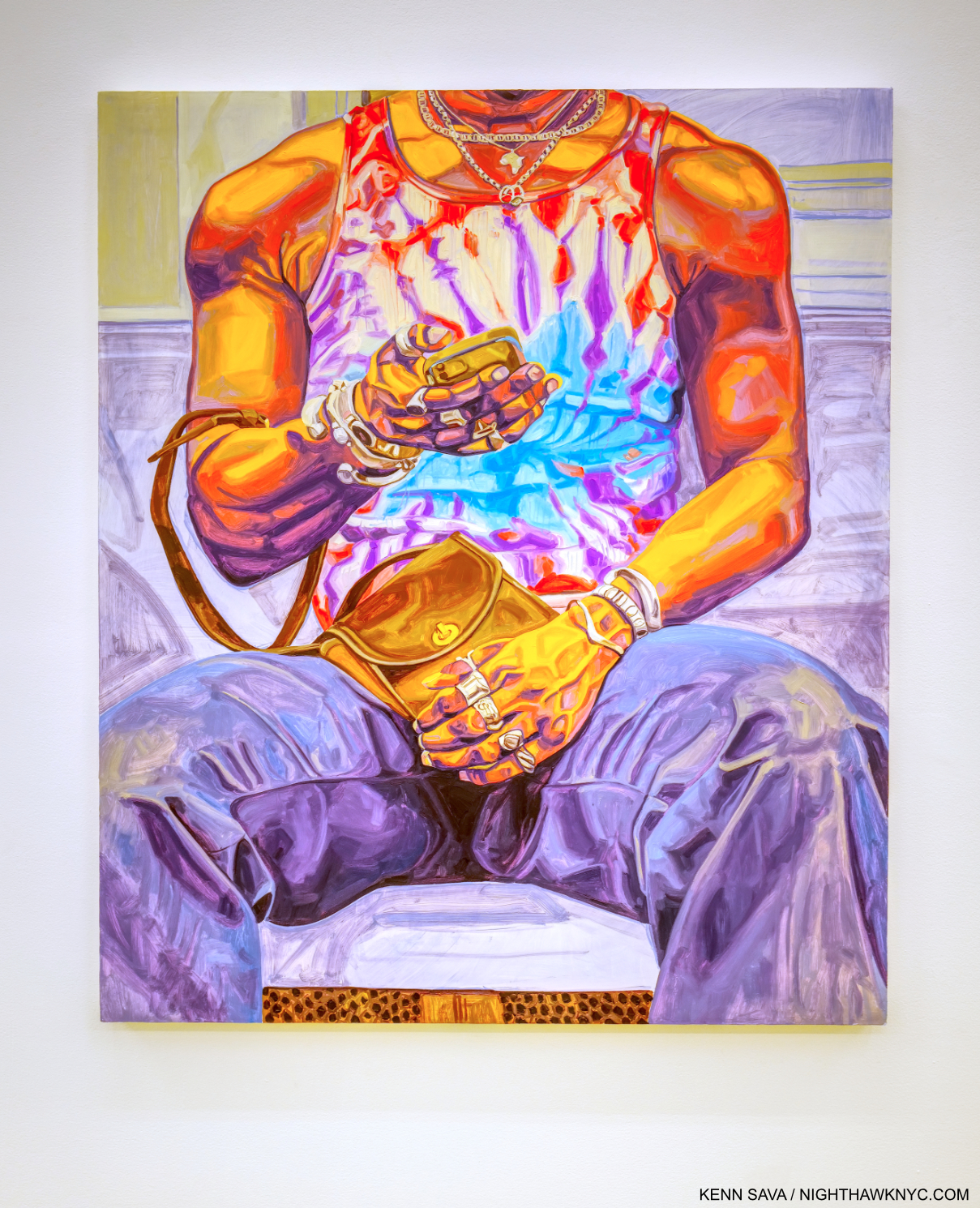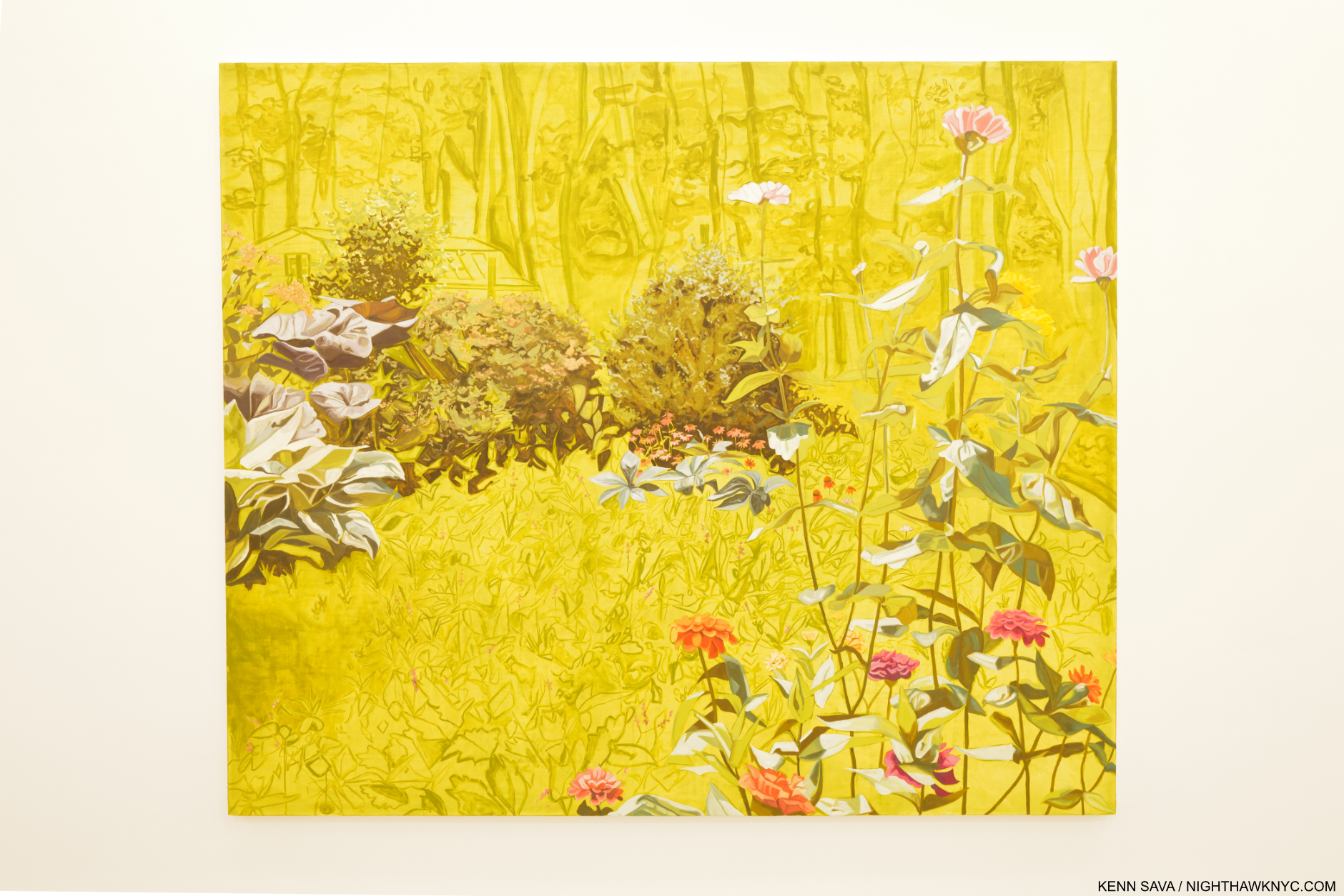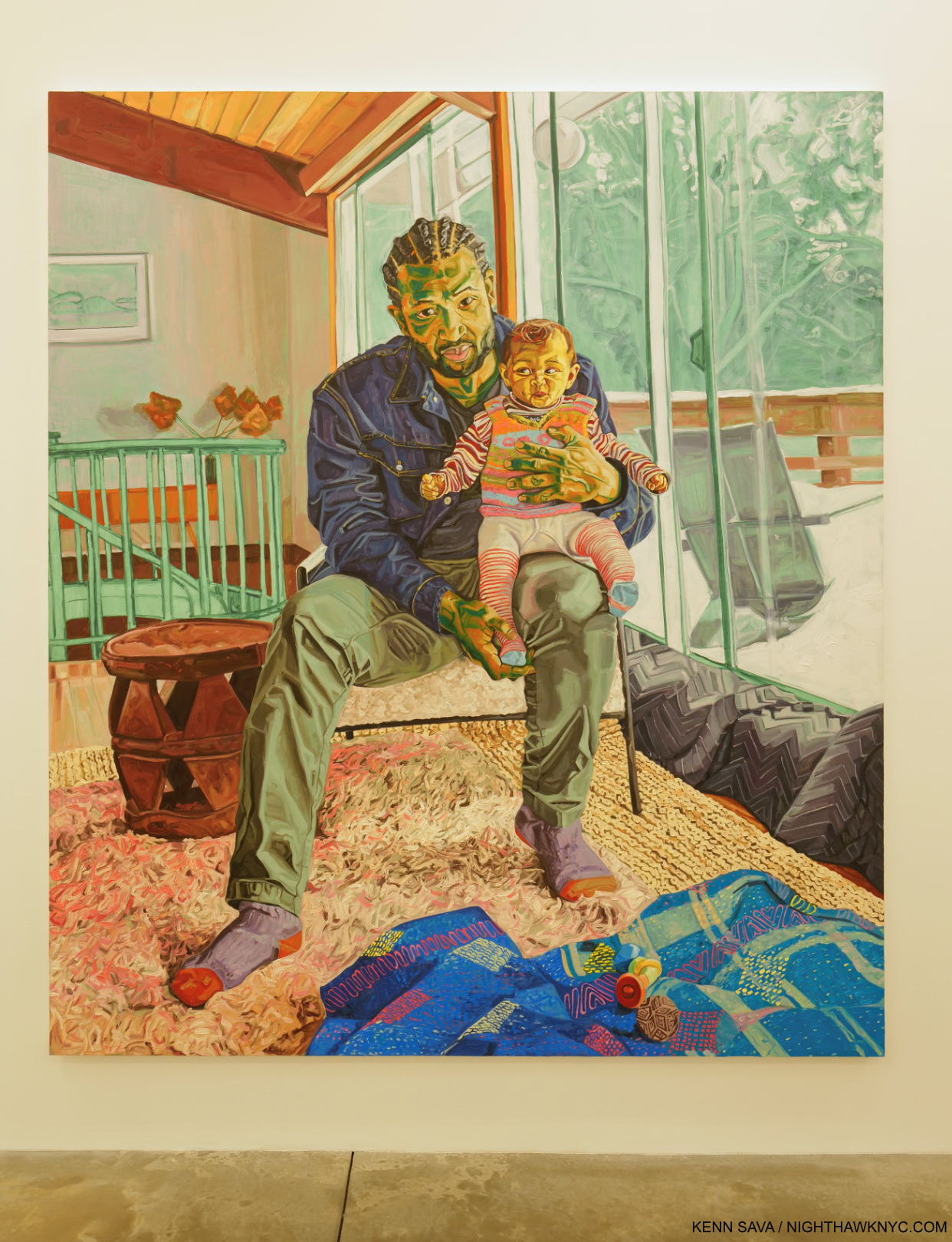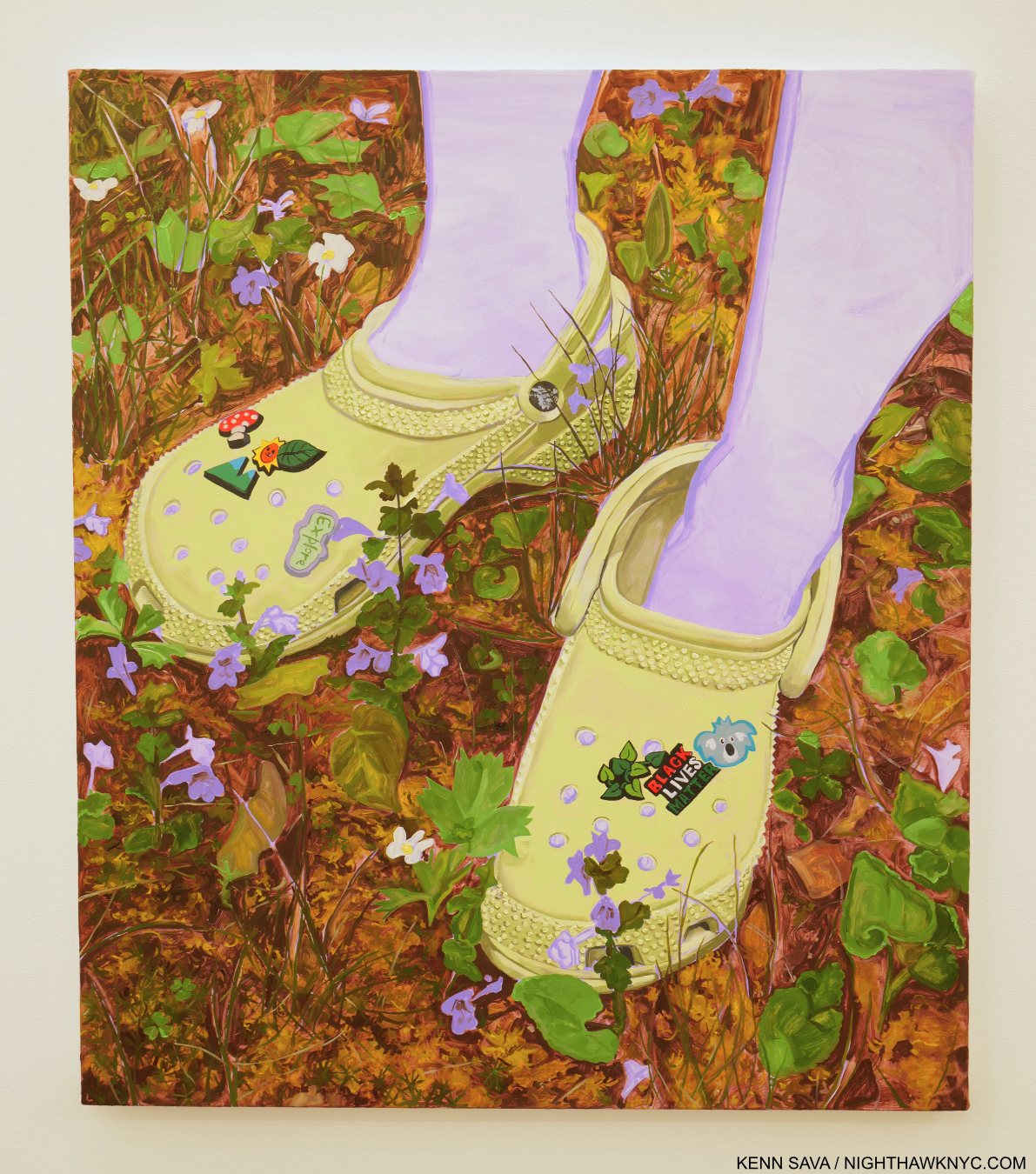This site is Free & Ad-Free! If you find this piece worthwhile, please donate via PayPal to support it & independent Art writing. You can also support it by buying Art & books! Details at the end. Thank you.
Written & Photographed by Kenn Sava.
Show seen: Henry Taylor: B Side @ the Whitney Museum
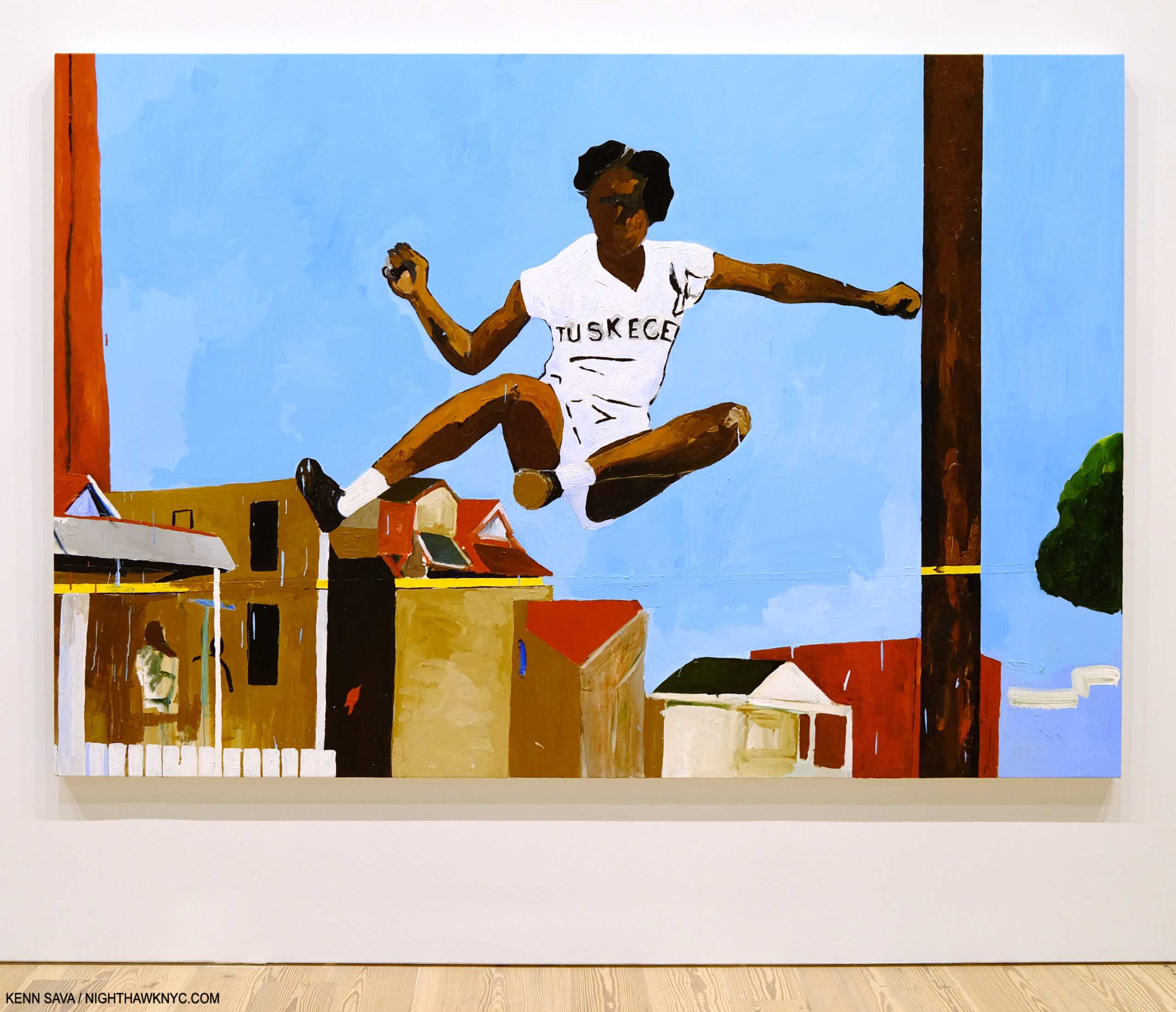
See Alice Jump, 2021, Acrylic on canvas, as are all the Paintings in this piece, unless specified. From the wall card- “The track-and-field legend Alice Coachman, depicted here, set a record in the high jump at the 1948 London games, becoming the first Black woman to win an Olympic gold medal. By altering the photo and positioning Coachman as if she is jumping over houses in a neighborhood, Taylor metaphorically alludes to the social and economic barriers she overcame growing up in the segregated South.” The pictures in this piece are thumbnails. Click any picture for full size.
I’ve had my eye on Henry Taylor since I reported that he was “Having a New York Moment,” as I called it in 2017 when he received the High Line Mural Commission simultaneously with being one of the “stars” of the 2016 Whitney Biennial. Okay, both eyes. The Artist returned to NYC in 2019 for a solo show at Blum & Poe, at which I met him.
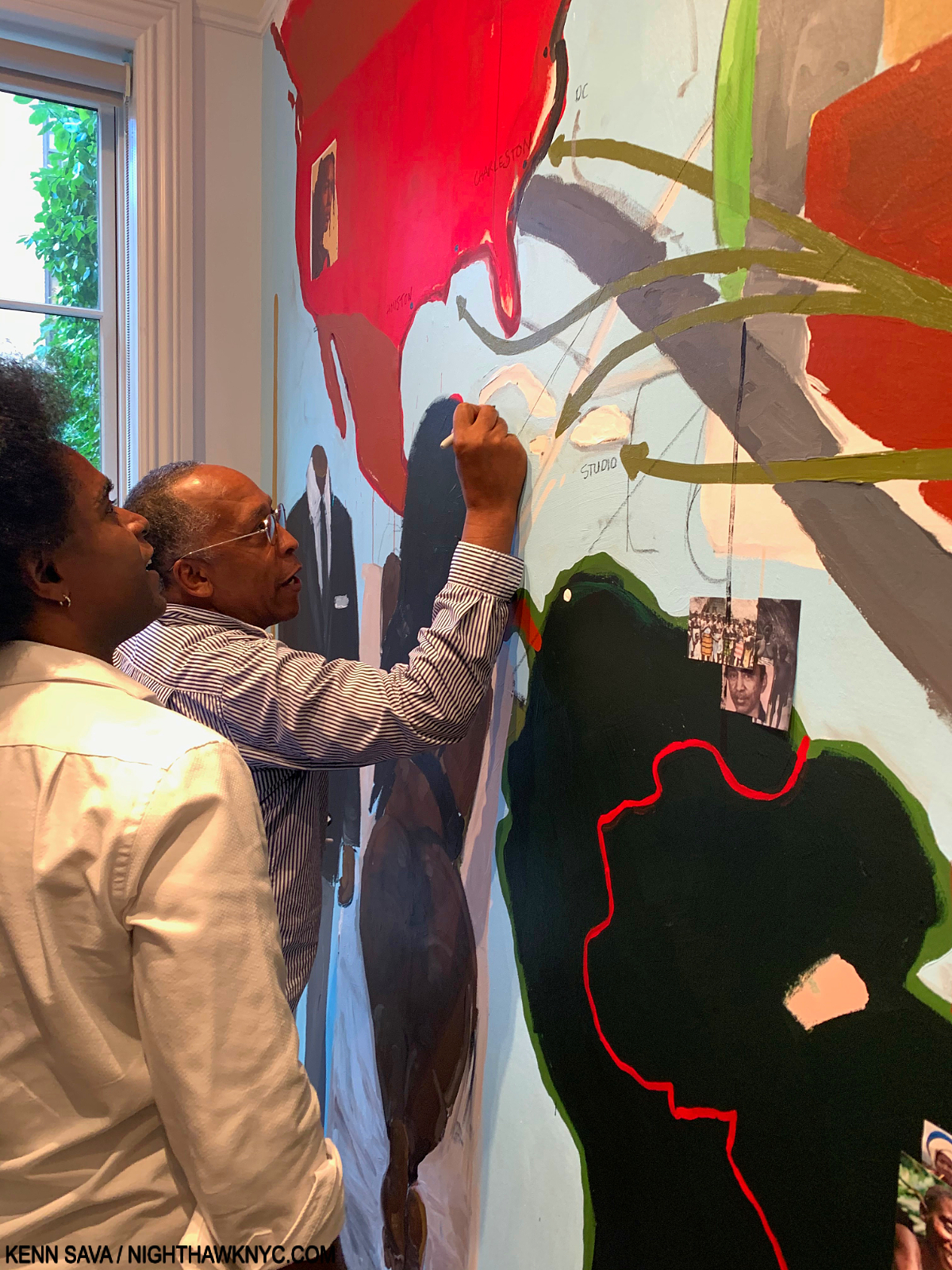
Henry Taylor modifying/ammending his wall-sized Mural with my Sharpie at Blum & Poe, September 24, 2019.
I lent him my Sharpie which he proceeded to use to modify the large Mural that was the centerpiece of his show as I watched with my mouth open. I then followed him to the terrace where he inscribed his outdoor installation with it. I’d never seen an Artist modify a work (or two) hanging in a show in my 40+ years of show-going before.
Needless to say meeting Mr. Taylor that night was an extraordinary experience made unforgettable by his being quite nice to me, and I don’t think it had to do with the pen. I came away feeling Henry Taylor is one very hard not-to-like man. I wondered if that might have been born in the fact that Henry Taylor is a “30-years in the making overnight sensation.” All this being said, everything I express about his Art here I felt before I met Mr. Taylor. Almost exactly four years to the day later, Mr. Taylor’s Art returned to NYC in Henry Taylor: B Side at the Whitney, his mid-career Retrospective, which only expanded my appreciation of the depth of his accomplishment and filled in the gaps.
B Side is the most powerful Painting show I’ve seen since Kerry James Marshall: Mastry at the lost and lamented Met Breuer in 2017.
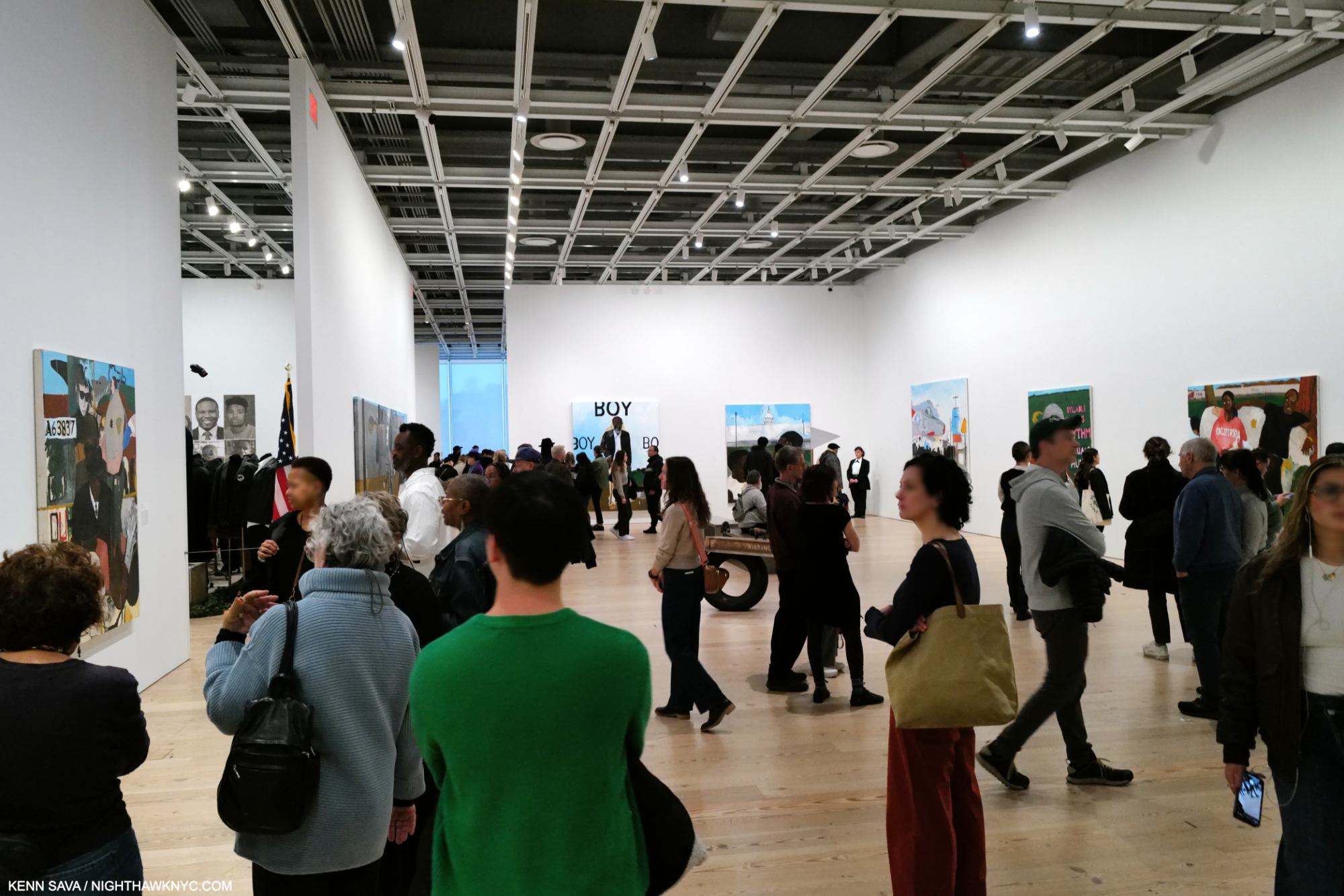
Now, or never! 4:30pm, January 28, 2024. One and one-half hours before Henry Taylor: B Side closed for the last time. Installation view of one of the two, large parallel galleries I mention further below. The other is behind the wall to the left.
This is remarkable because Henry Taylor was so late in getting his Art career started.
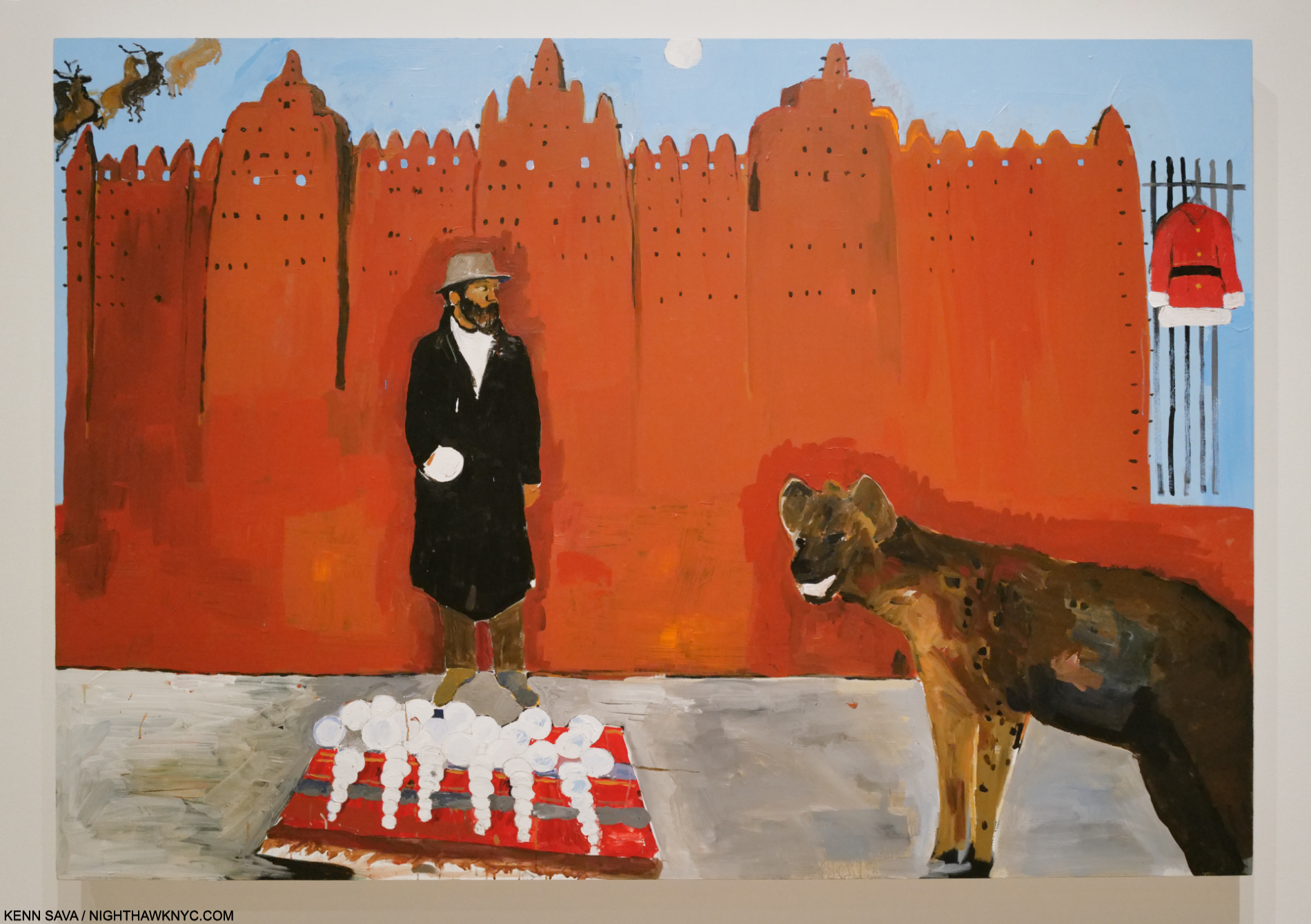
Hammons meets a hyena on holiday, 2016. Henry Taylor is a student of Art history and an entire gallery was devoted to works inspired by the work of other Artists. Here, he riffs on Dawoud Bey’s famous Photo of David Hammons selling snow balls one winter day in 1983.
The first thing that might catch a viewer’s eye is his palette. On a number of occasions his colors caught my eye from hundreds of feet away across large rooms. For that reason alone, a full Retrospective of his work over 6 galleries of the Whitney Museum’s 5th floor this winter, was a thing of beauty.
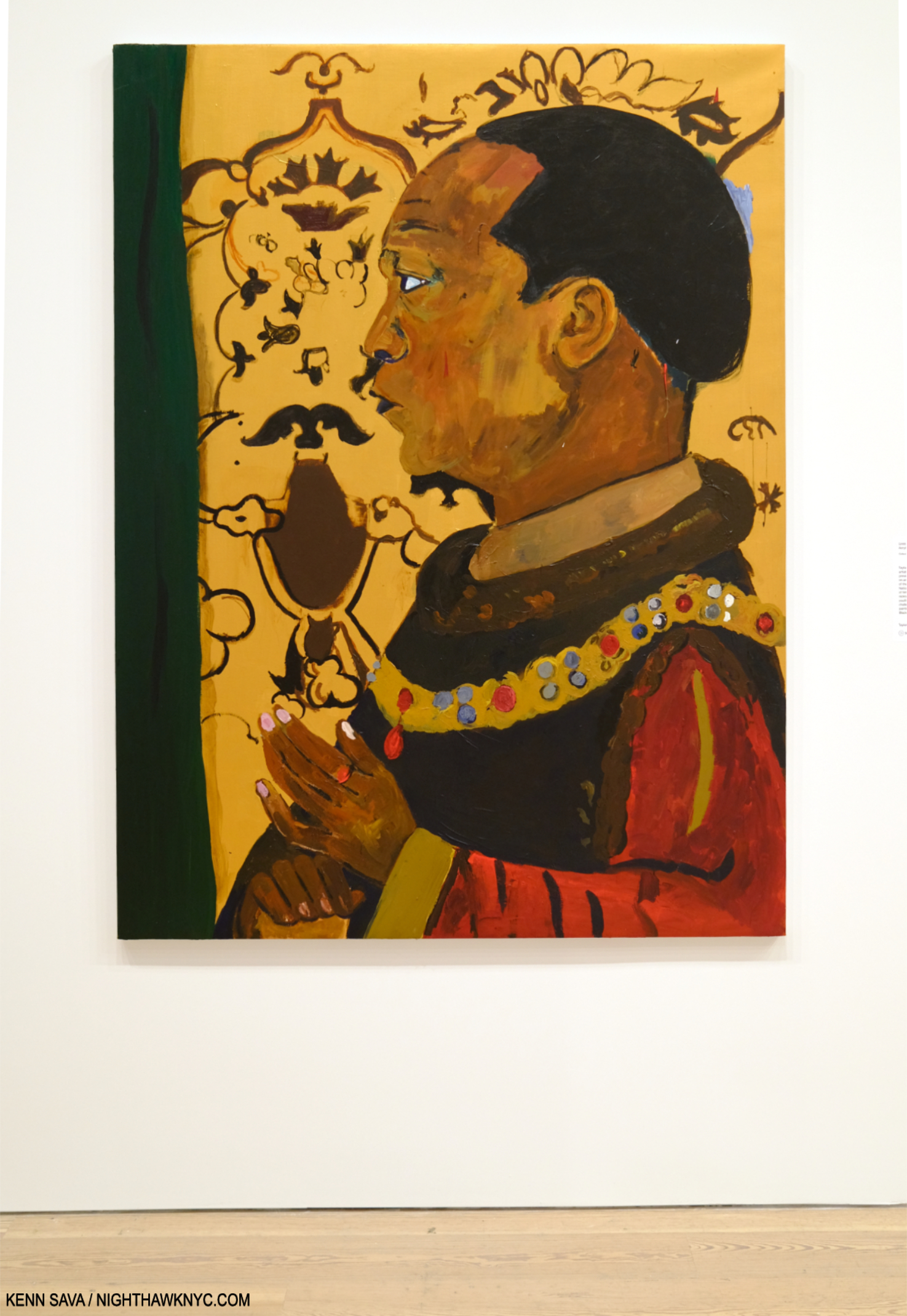
Untitled, 2021, Acrylic on linen. In fitting with the show’s title, here the Artist “covers” a Painting he saw in London’s National Portrait Gallery of King Henry V. This could be a play on his nickname- “Henry the VIII,” being the youngest of 8.
But life is not full of blue skies, roses, or bowls of cherries, and neither is Henry Taylor’s Art. There’s much, much more to be seen in his work. As enchanting as his palette is, it’s the depth of his content and his unique way of presenting it that sets his Art apart.
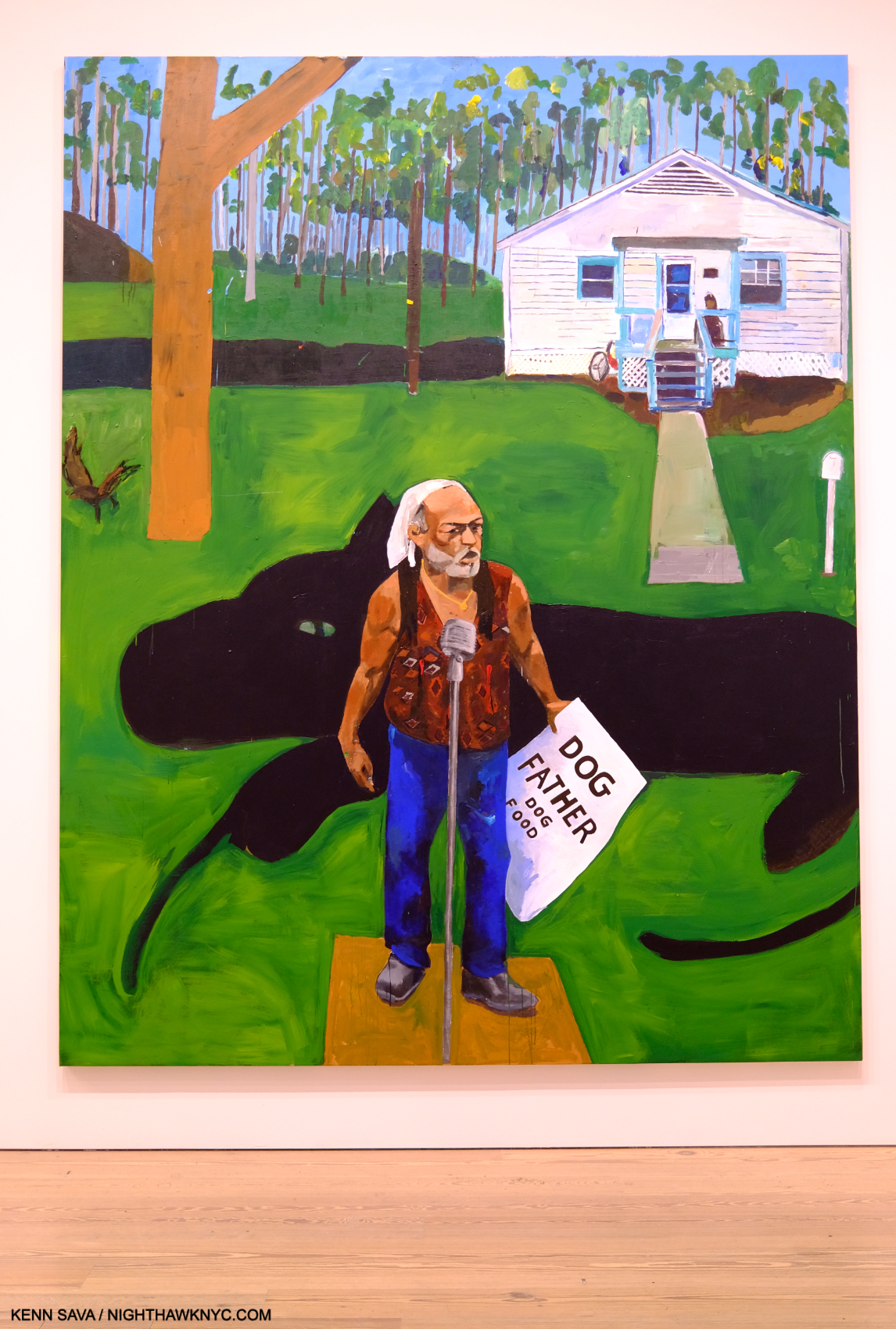
Untitled, 2022. A Portrait of the Artist’s brother, Randy, a former Black Panther (with a large one looming behind him) and now a dog breeder in Texas, depicted looking like he’s about to give a speech as he did in those earlier days.
That content speaks to a very wide range of subjects. Perhaps, most well-known for his Portraits, which as Antwaun Sargent points out, differ from the work of Kerry James Marshall in his preference for “the outcast,” as he calls them1. This is fitting for a show titled B Side, which is a reference to the other side of a single 45rpm record. The B Side of a hit 45 was almost always something overlooked and rarely played, except by devoted fans. It can also be a collection of lesser known or cover songs (like the album B-Sides, by Oasis). Both seem to fit the show. Yet, along with outcasts, B Side contains numerous Portraits of icons- political, Musical, and athletic. Throughout, it seems to me Henry Taylor Paints his subjects from the inside, out. Something quite remarkable. My impression is that he does it through empathy; from connecting and relating to the person he’s depicting in some way- even if he’s never met them, as in the Portrait of Alice Coachman up top. As good as his Art is, in the end, empathy might be what separates Henry Taylor.
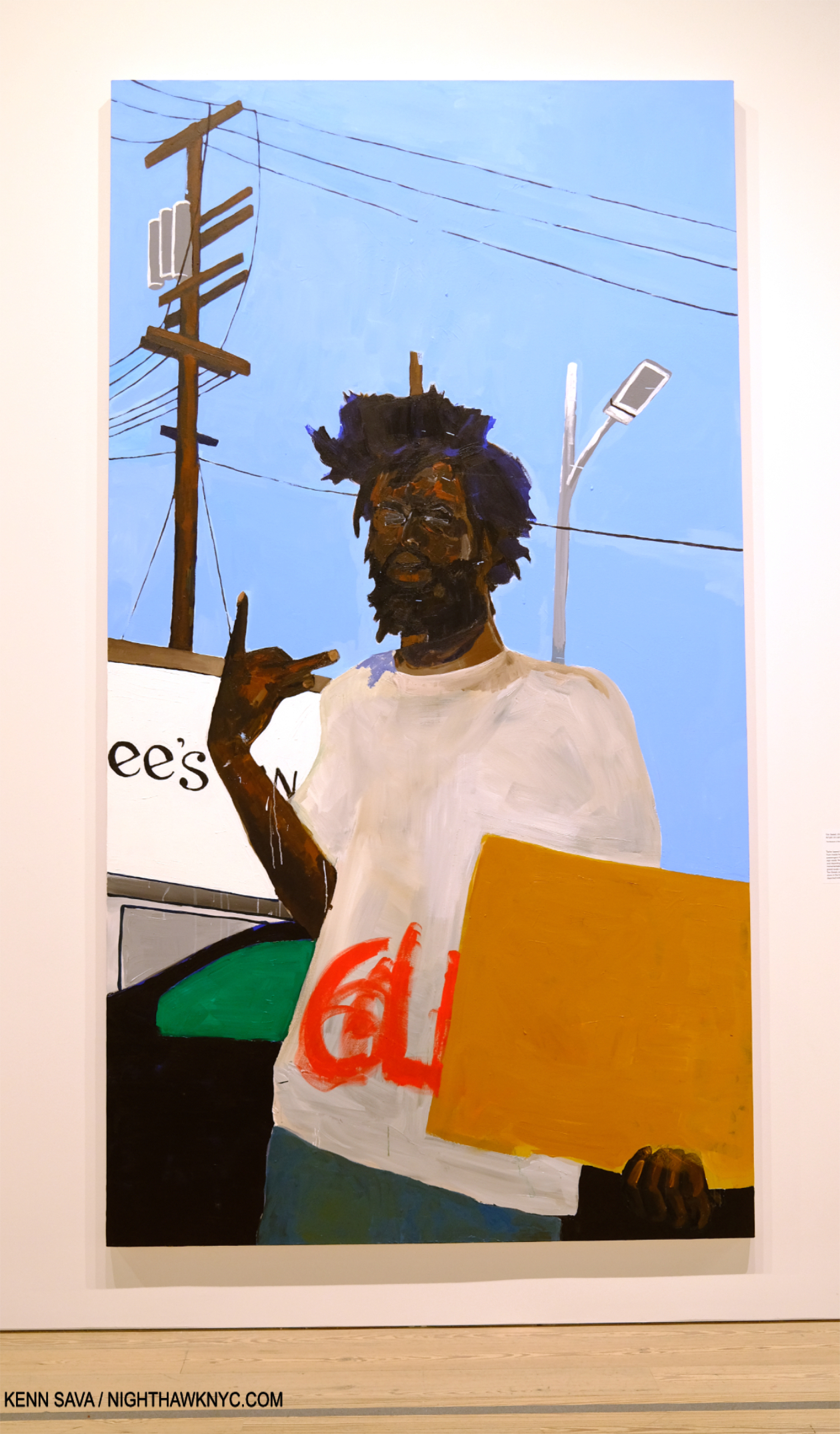
Too Sweet, 2016. This extraordinary Portrait is based on a Photo the Artist took from inside his car as this man approached seeking help from passing motorists. A whopping 132 x 72 inches, its monumentality is furthered by viewing the figure from below. It’s also an example of the Artist selectively blurring facial details, in this case his eyes, which occurs off and on in the show, and which I find endlessly fascinating. I wasn’t a bit surprised to find out that MoMA has acquired it.
B Side complements his Portraits with a wide range of scenes from everyday life, with the specter of racism, and its impact, hovering as the omnipresent horror it is and has been, never far away. Of course, Mr. Taylor is well-acquainted with the reality of racism. Some of his Paintings on the subject of his grandfather hint that his 1933 murder in East Texas may be a continuing influence, as could well be expected. In fact, this was the subject of the large Mural, Ancestors of Genghis Khan with Black Man on Horse, 2015-17, which graced one of the lobbies of the 2017 Whitney Biennial, as I showed here.
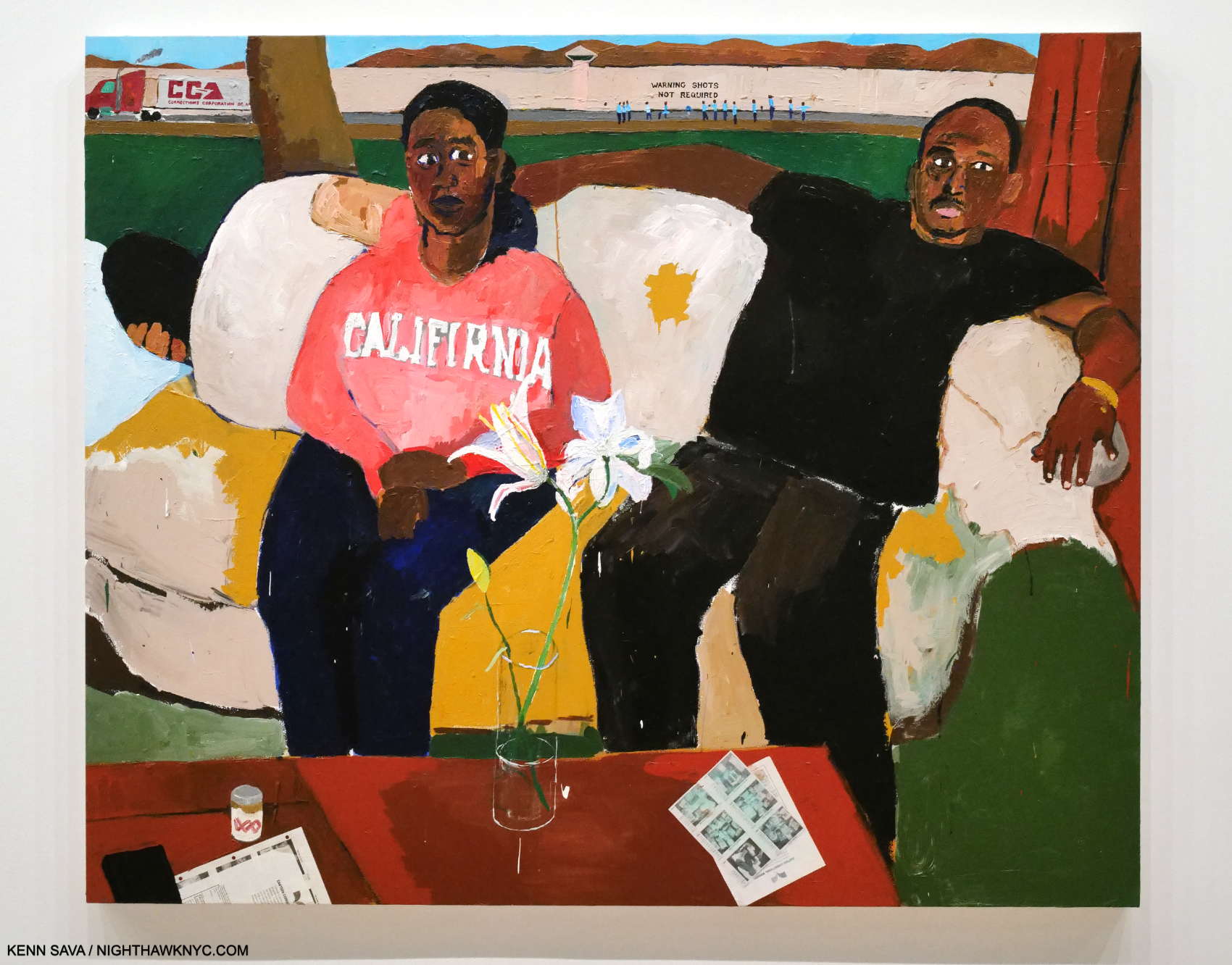
Resting, 2011, Acrylic and collage on canvas. Taylor depicts his niece and nephew sitting on a couch at home with a reclining figure behind them. Further back is a Corrections Corporation of America truck, a line of uniformed men, and a wall with “WARNING SHOTS NOT REQUIRED” stenciled on it. Before the couple are Canteen Correctional Services forms for family members to authorize items prisoners can purchase at the commissary.
Most often, but not entirely, his subjects are Black, and with the body of work he has created over the past 30 years, Mr. Taylor has emerged as “one of the most powerful and poignant observers on what it means to be Black in America working today1.”
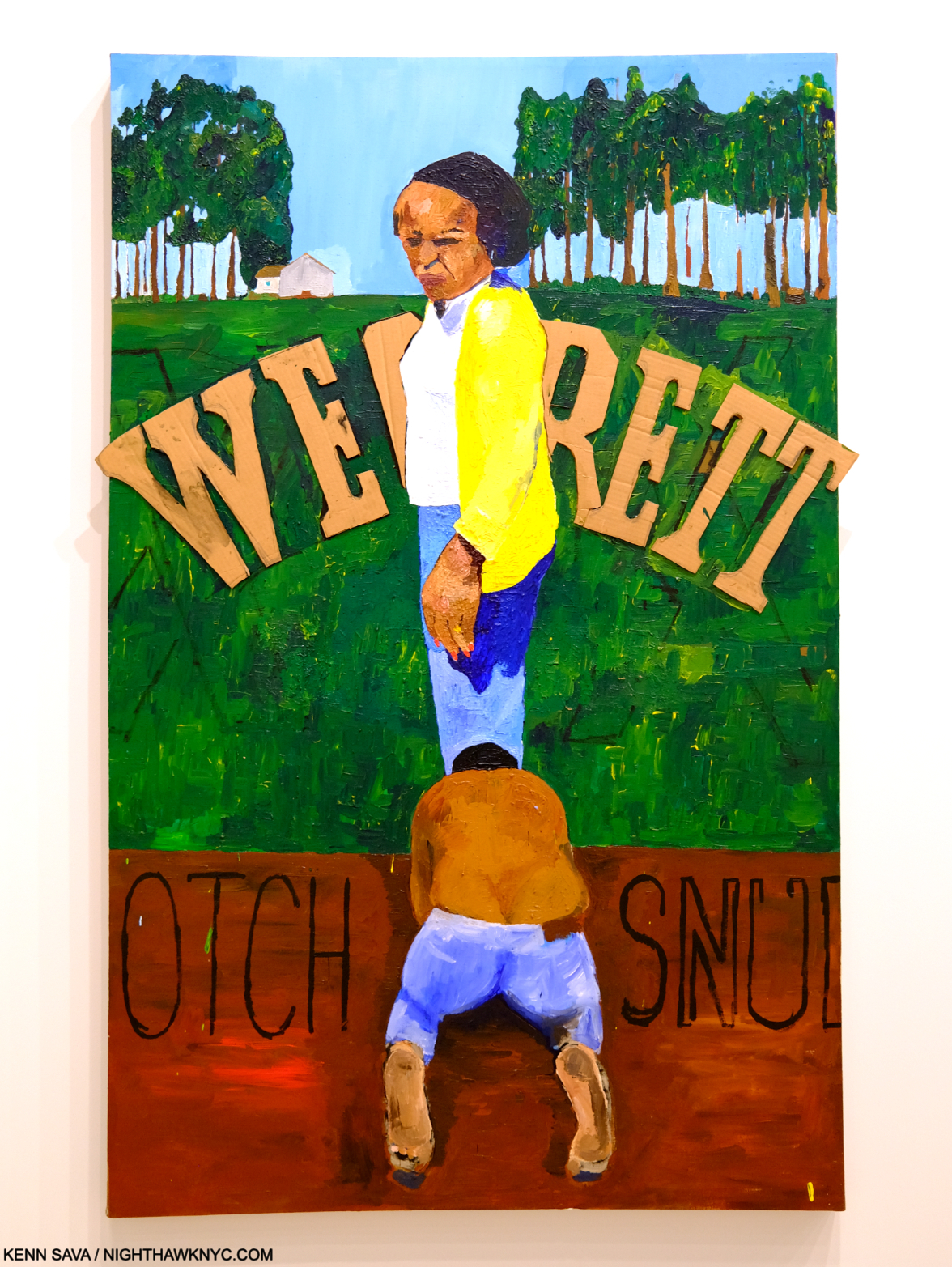
Wegrett, 2006, Acrylic and cardboard collage on linen. One of the most unique Portraits of an Artist with his mother in Art. The collaged cardboard seems to read “WE REGRET.” The wall card says- “Here, the words may allude to the pain he feels about the hardships his mother faced in her life. As Taylor explained, ‘I painted a picture of myself on my knees in front of my mama, and I don’t know why I painted that, but I just did, and I know I cried on that.'”
To complement his range, the show has been arranged by theme. As a result, B Side is a bit like a story with chapters; beginning with family, moving to his early creative days, and then to the subjects that hold his attention as a mature Artist. His current level of success doesn’t seem to have changed him or his Art one iota. Everything he’s done has that feeling of having been cut from the same cloth.
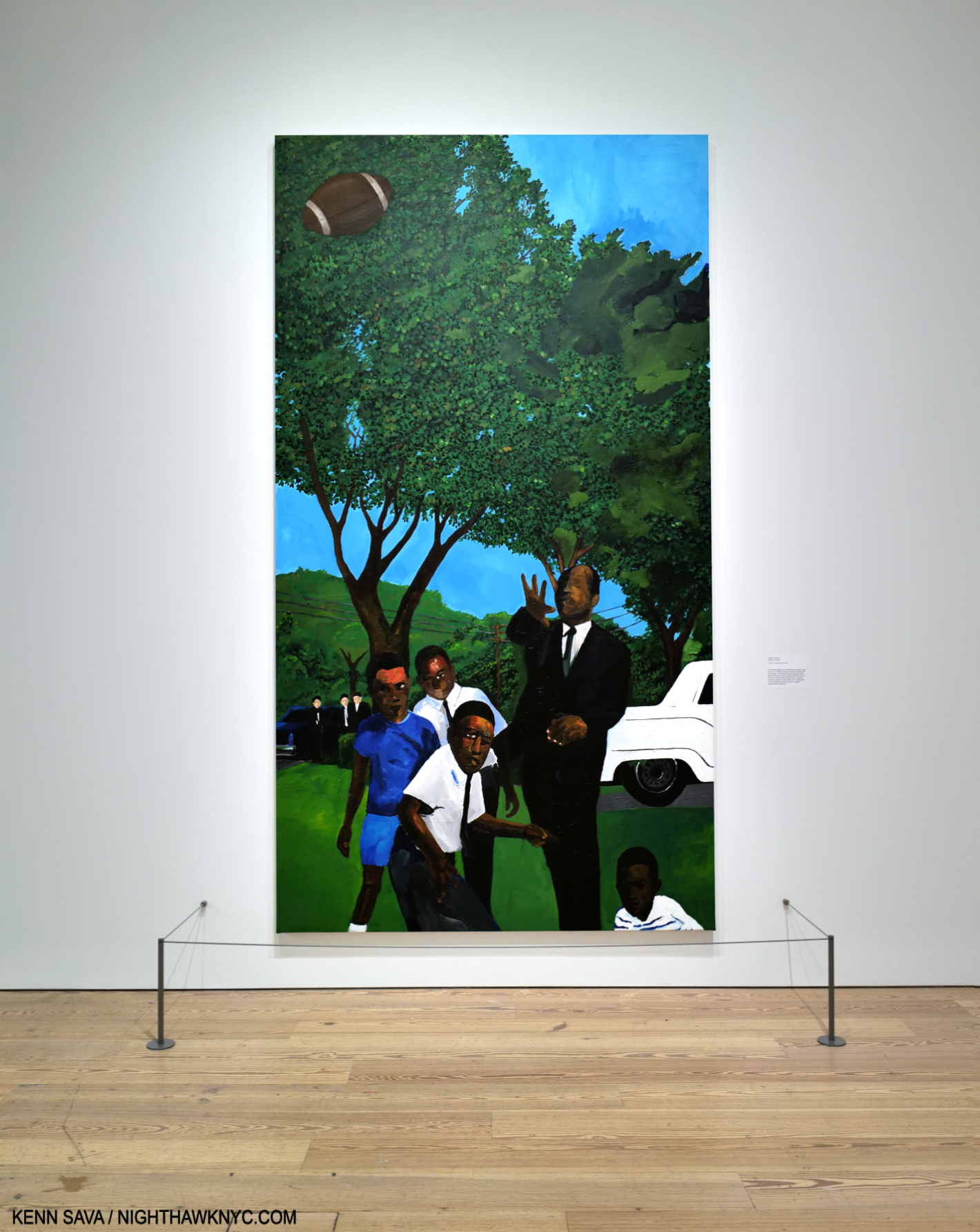
Untitled, 2016–22. Dr. Martin Luther King plays football with some kids while 3 ominous figures watch from the rear.
The first two galleries are devoted to Portraits, with an emphasis on his immediate and extended family, and some Self-Portraits. It’s hard to think of another Artist who has Painted his extended family so often and so strikingly (as in Untitled, 2022, shown earlier, of his brother, Randy- one example). Throughout B Side, I was fascinated by the Artist’s choices in creating his Portraits. Specifically, his choices of when and which facial details to include (as in Untitled, 2016–22, above, and Too Sweet, 2016, earlier). Are these done to cause the viewer to look elsewhere besides the face, or to make them look closer? This is a bit reminiscent of what Edward Hopper did on occasion, as in his Room in New York, 1932, as I discussed here.
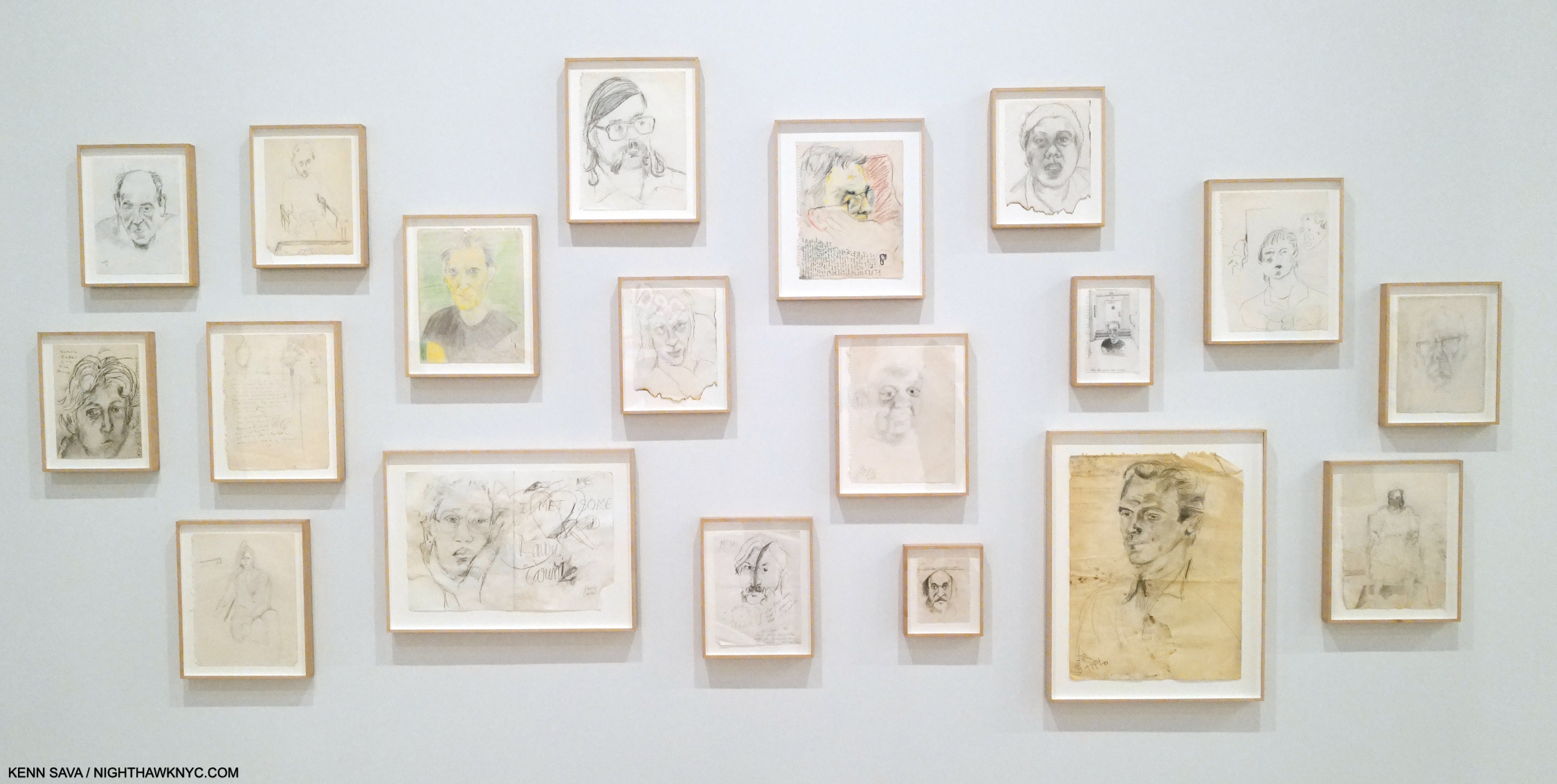
First work. A collection of Henry Taylor’s Portrait Drawings of patients he worked with at Camarillo State Hospital, 1985-95, Graphite on paper. One is Pastel, colored pencil and ink on paper. These date from during his time as a student at Oxnard Community College and then the California Institute of the Arts (aka CalArts).
The third gallery took the viewer back to Henry’s beginnings as an Artist. Born in 1958, he spent the decade from 1984 to 1994 working as a psychiatric technician at Camarillo State Mental Hospital, Camarillo, CA.3. During this time, he created his earliest known work, Drawing and Painting a number of the patients he worked with: adults living with developmental disabilities or mental illness as well as those seeking treatment for substance use disorders, developing close relationships.
“I learned not to dismiss anybody,” he recalls. “It just made me a little more patient, a little more empathetic. It taught me to embrace a lot of things. A lot of people will avoid a person who doesn’t appear normal, but I’m not like that.” Henry Taylor, in a must-read 2016 interview, here.
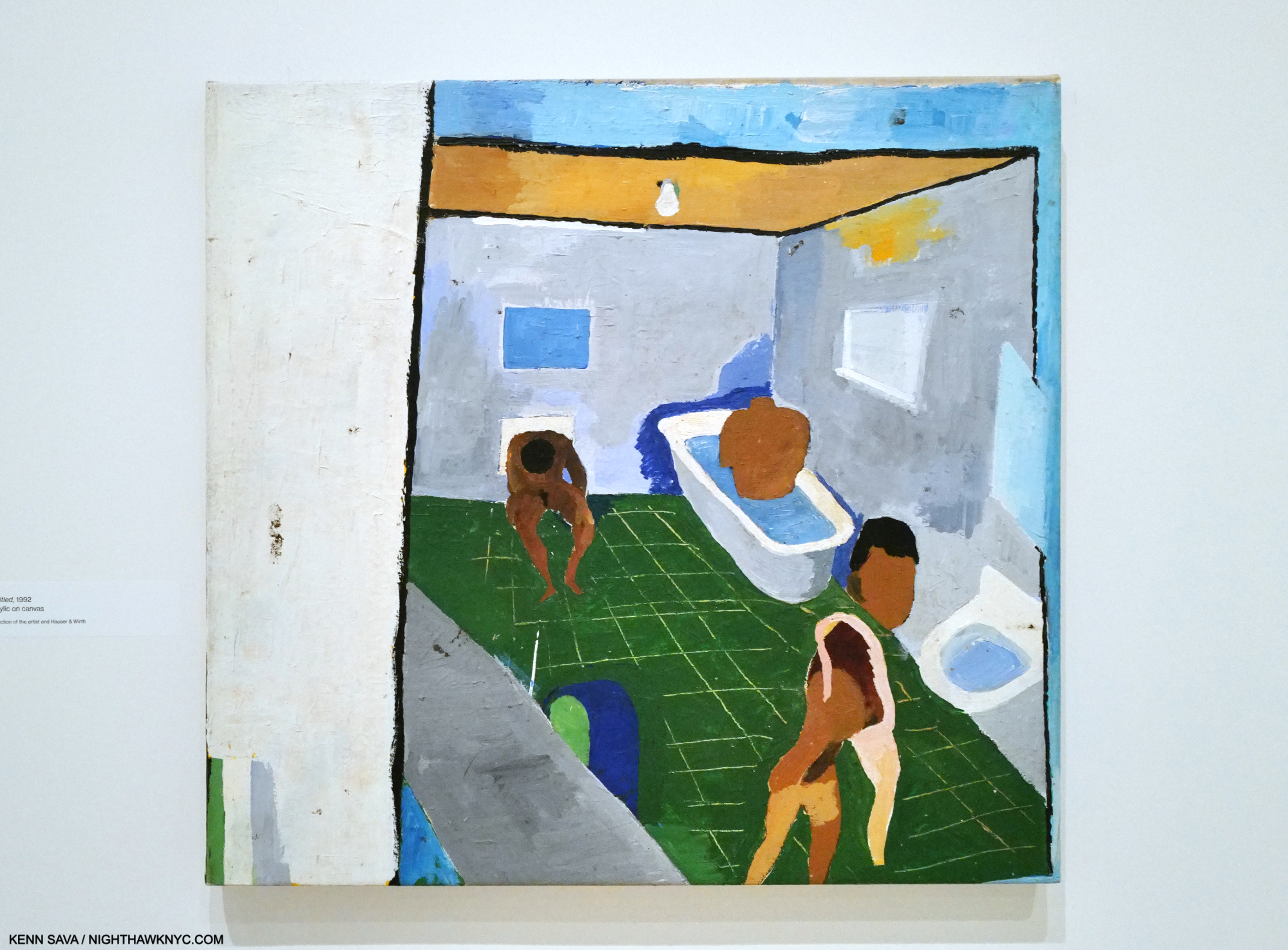
Untitled 1992. One of the earliest Paintings in the show. When B Side opened in October, I was buried in my piece on Van Gogh’s Cypresses which I published in November. Cypresses mostly takes place when Vincent was a patient in an insane asylum. Therefore, it was impossible for me not to make a connection between Henry’s experiences and Vincent’s. When I first saw this Painting, I was immediately reminded of Photos of the bath tubs Vincent was assigned to for therapeutic treatment in the San Remy Asylum almost exactly a century earlier.
For the last half of that decade as a psych tech, he was also a student at CalArts where he was at least a decade older than his fellow students, graduating in 1995 (among numerous others, Ed Ruscha was a 1961 graduate). Henry began his Art career at 37. After struggling to find representation and recognition, the world has gradually caught up with him to the point that 30 years on, he’s now one of our more influential and respected Artists, with a blockbuster Retrospective that appeared at the Museum of Contemporary Art (MOCA), L.A. before moving to the Whitney.
Working with his patients turned out to have a decisive impact that would continue in everything he’s done. Early on in his career after graduating, Paintings, like this one, continued to speak to his Camarillo experiences.
From there the visitor emerged into two large parallel galleries that lie at the center and heart of the show largely focused on being Black in America. The first one ranges from a 4th of July cookout to incarceration to the show-stopping THE TIMES THAY AIN’T A CHANGING FAST ENOUGH, 2017, depicting the murder of Philandro Castile. On the other side of the wall, the other large gallery features Paintings related to the Black Panthers and a large installation recreating a Black Panther speech with appropriately attired mannequins.
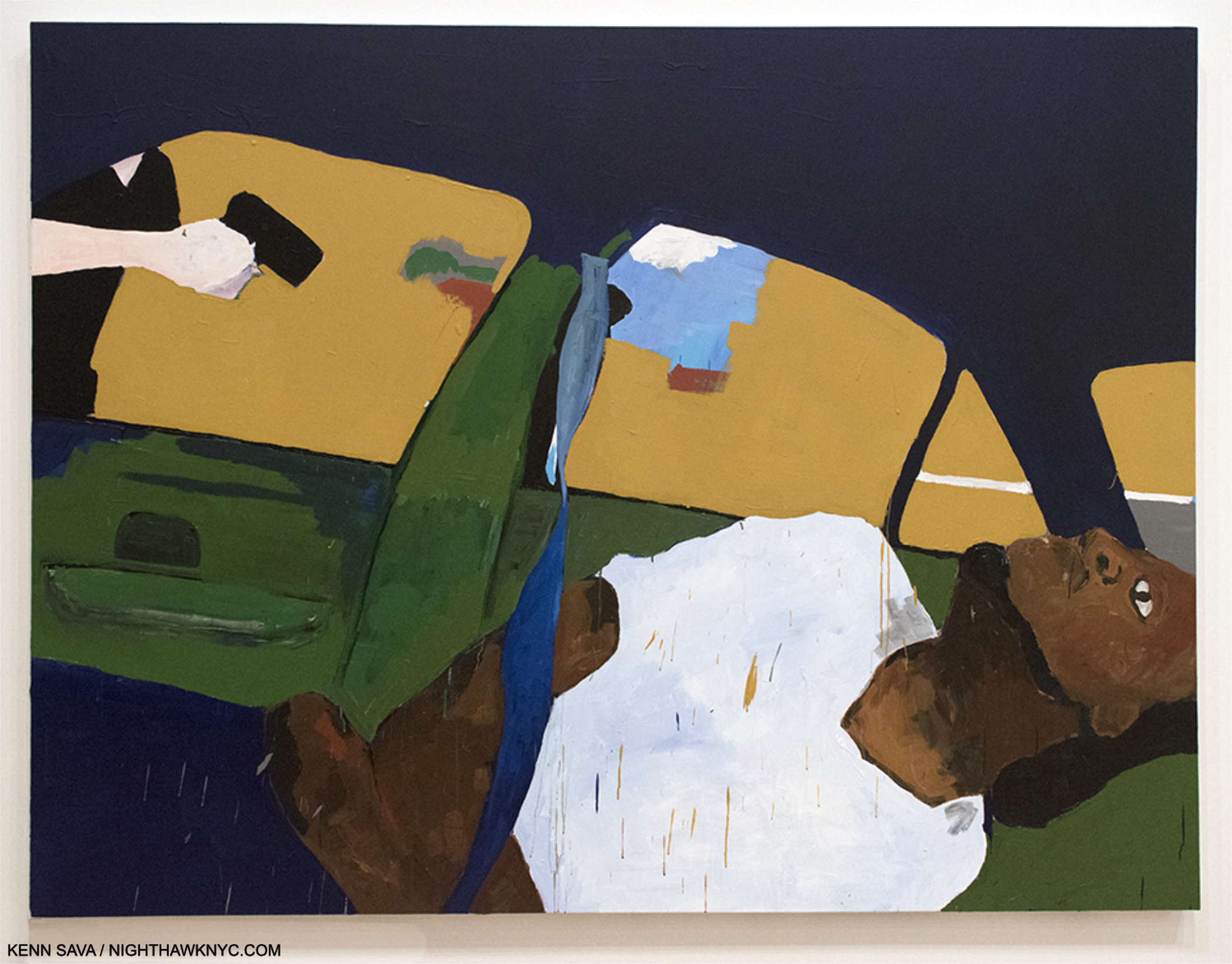
THE TIMES THAY AIN’T A CHANGING FAST ENOUGH, 2017. Per the wall card- “Taylor has said that he was motivated to paint this scene immediately upon learning about it- ‘I don’t even think I thought about ever showing that one when I painted it; it was just something I had to get out of my head.'”
THE TIMES THAY AIN’T A CHANGING FAST ENOUGH is the most powerful Painting I’ve seen this century. It’s hard for me to think that history worn’t regard it as akin to a (Goya’s) The Third of May 1808 of our time.
“Taylor’s paintings occupy a new and different space within Black radical aesthetics,” Charles Gaines, Artist4.
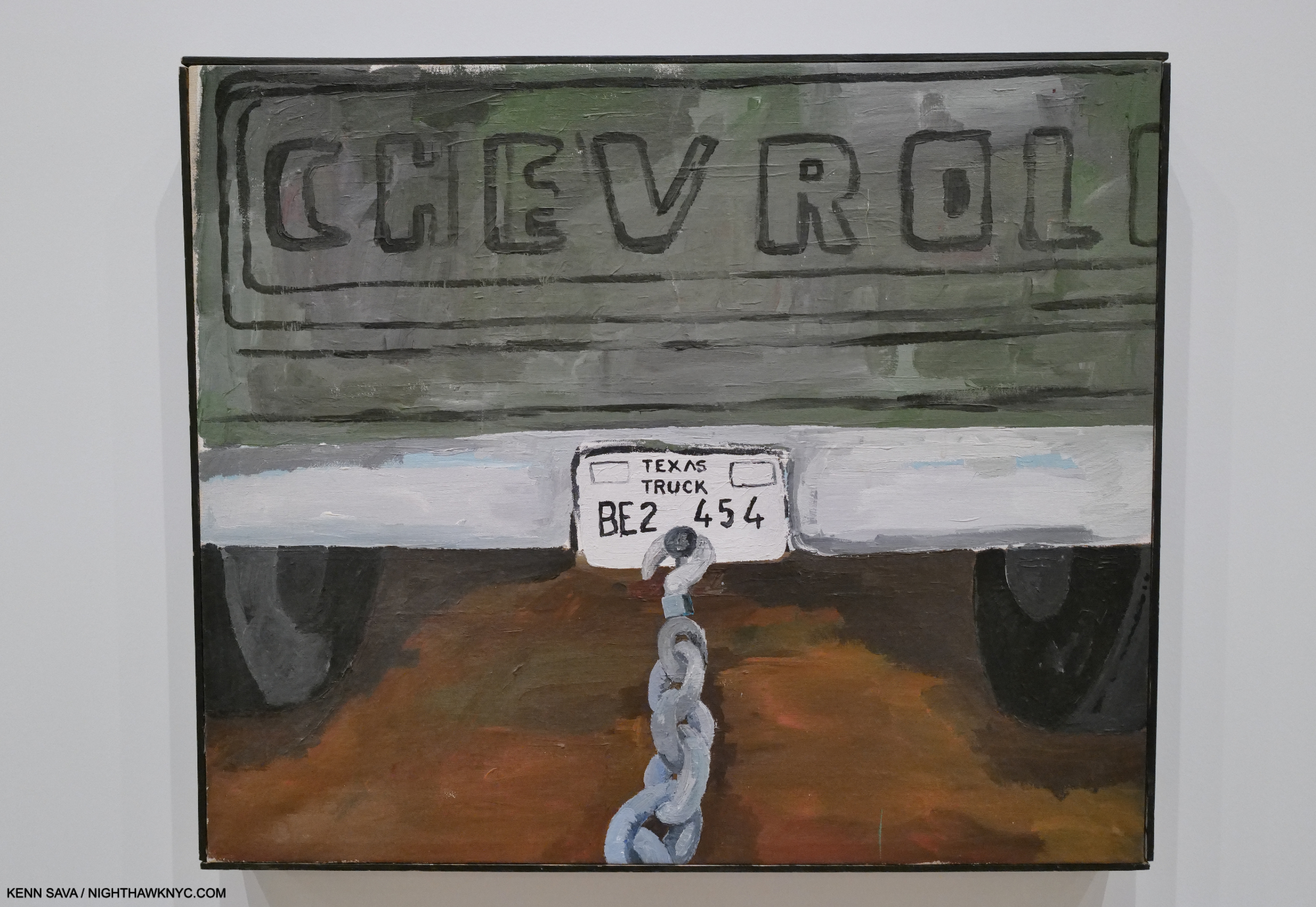
too much hate, in too many state, 2001. From the wall card: “This painting places the viewer in the vantage point of James Byrd Jr., a Black man who was abducted and murdered on June 7, 1998, in Jasper County, Texas, by three white supremacists who chained his ankles to the back of their pickup truck and dragged him to his death. The brutal murder led to a national outcry, prompting calls for stronger hate crime legislation.”
While it’s front and center in THE TIMES THEY AIN’T A CHANGING FAST ENOUGH, and too much hate, in too many state, “social criticism” in Henry Taylor’s work is often equally subtle, but always sharply on point. On the other side of the wall was a large gallery centered around the Black Panthers, including this remarkable installation-
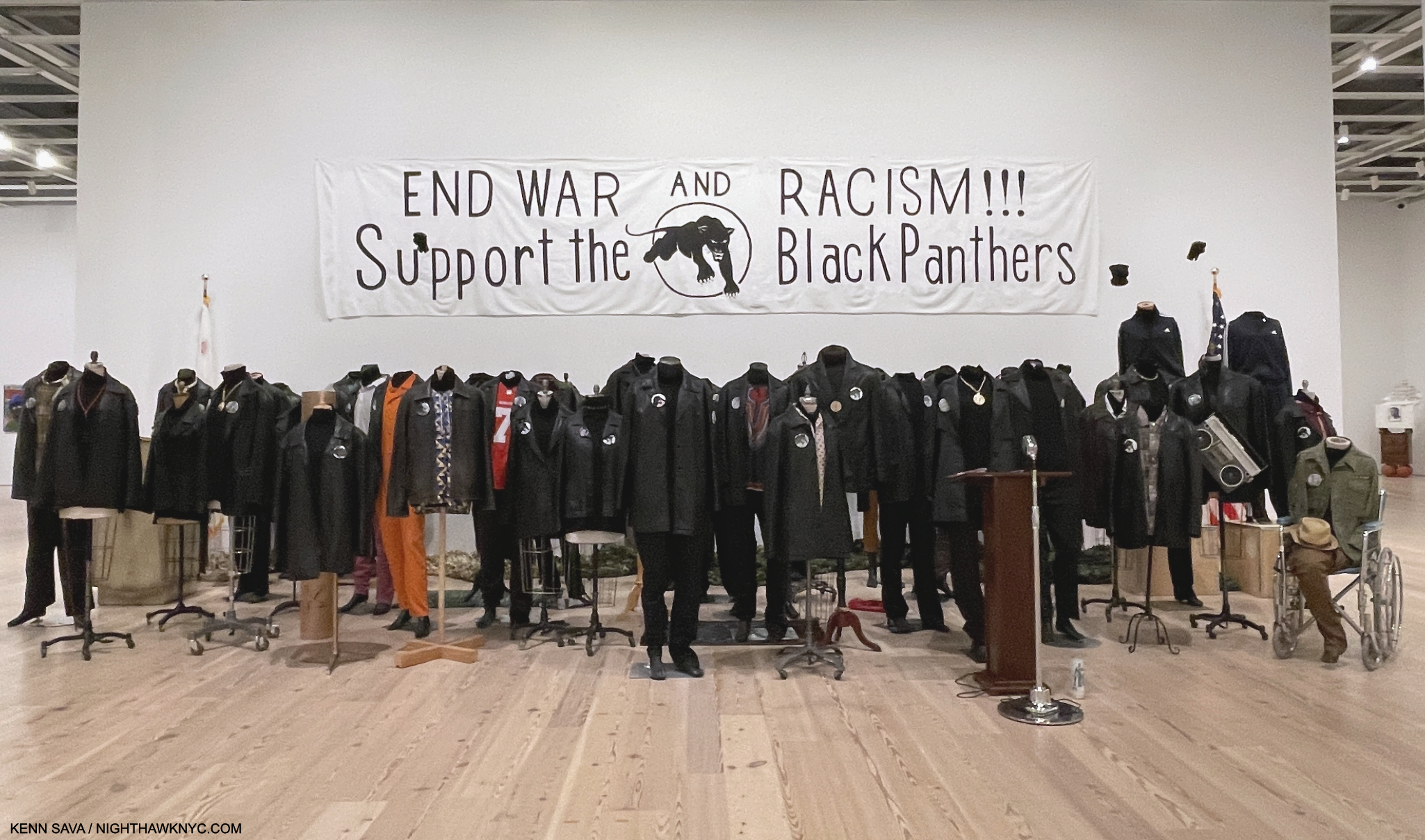
Untitled, 2022, Mannequins, leather jackets, and posters, including a Colin Kaepernick 49ers jersey.
The wall card informs us that Mr. Taylor created this installation to honor the Black Panthers and his brother, Randy, who was active in his local branch. Adjacent to it were Photographs of many of those recently killed by police, bringing past and present together. On the other two walls of the gallery were Paintings of former Panthers Huey Newton, and this remarkable rendering of Eldridge Cleaver, looking like you-know-who out of James Mc Neill Whistler.
Along with the outcast, B Side also showed figures who have gone on to attain and achieve: quite a few of them.
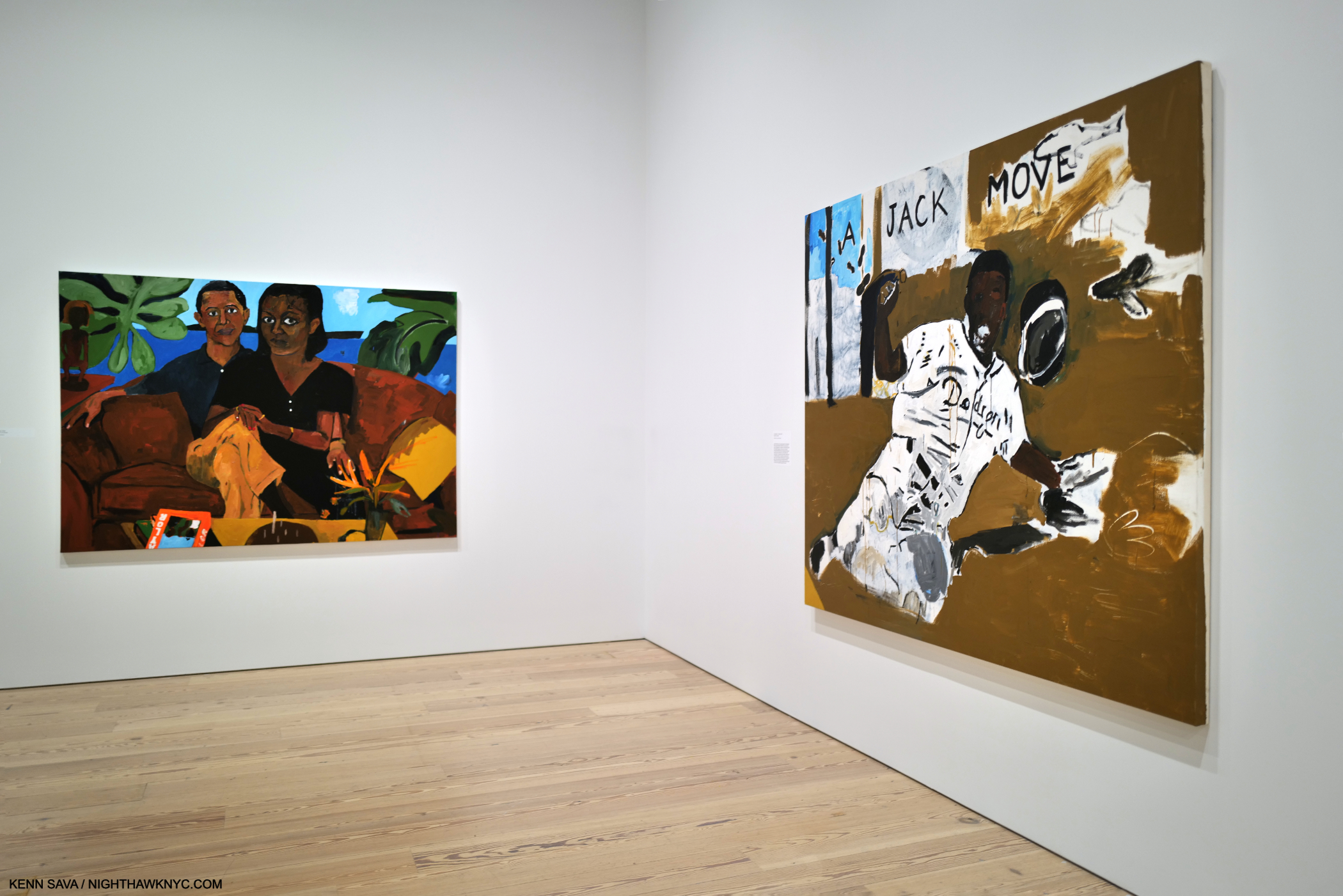
A counterpoint to his Portraits of the overlooked and outcast, was a room of Portraits of celebrities, that included Chuck Berry, Jay Z, and Haile Selassie, were this Portrait of Jackie Robinson, A Jack Move-Proved It, 2011, right, and Michelle & Barak Obama, Untitled, 2020, left, sporting a copy of the Henry Taylor Rizzoli monograph of their coffee table.
And then there was this remarkable pairing-
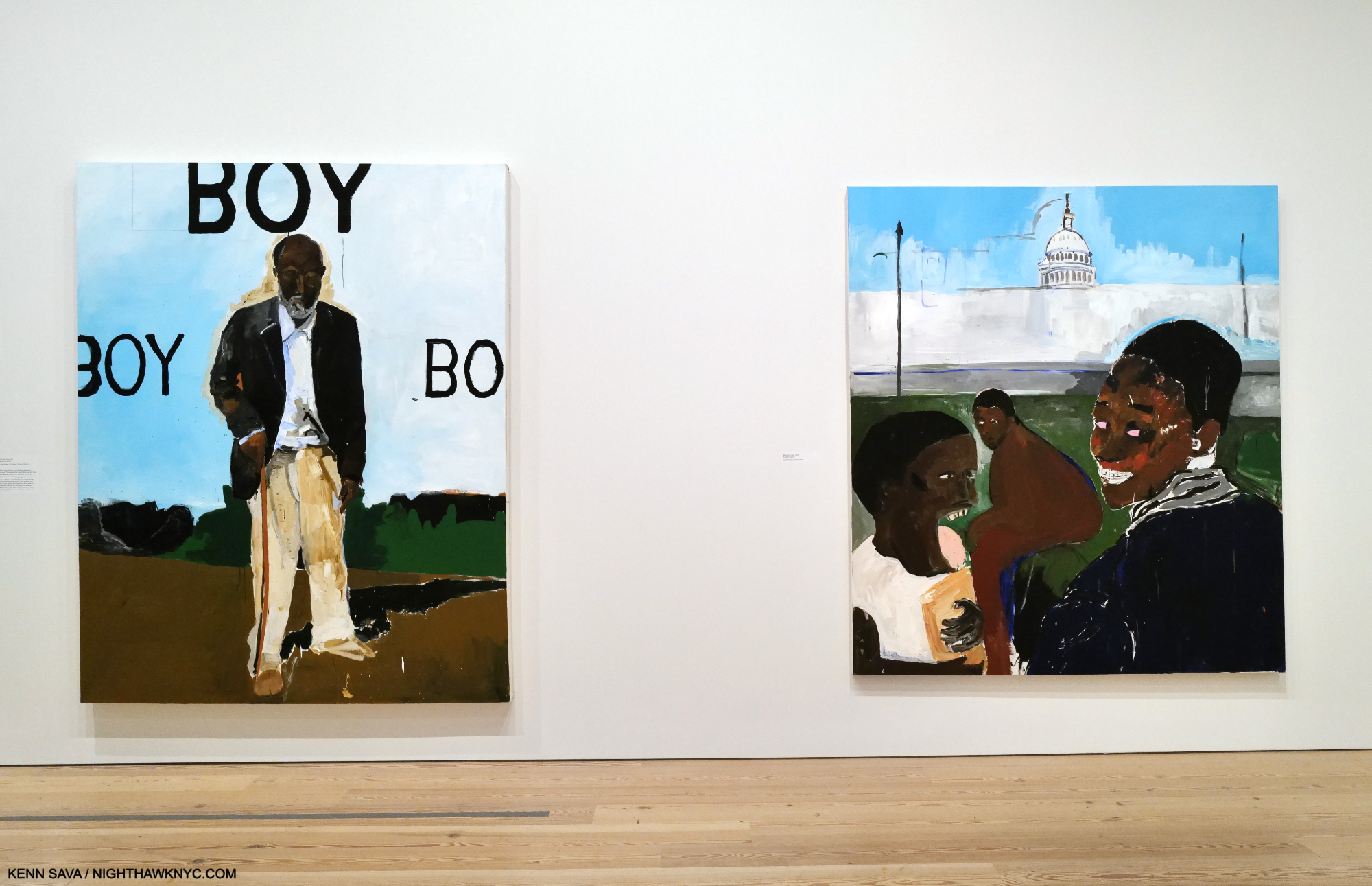
That Was Then, 2013, left, depicts an older Black man who has probably heard the racist slur surrounding him many times, and Watch Your Back, 2013,
Fresh, exciting, bold, beautiful, direct yet mysterious, subtle and powerful, the Art of Henry Taylor has something for everyone, and I suspect that people many years in the future will continue to find that in it. B Side was a show that honored “outcasts” and the inspiring achievements of icons side-by-side, while pulling no punches about the world both of them, and the rest of us, live in.
For all those reasons Henry Taylor: B Side was a landmark show. A near perfect mid-career Retrospective in my view.
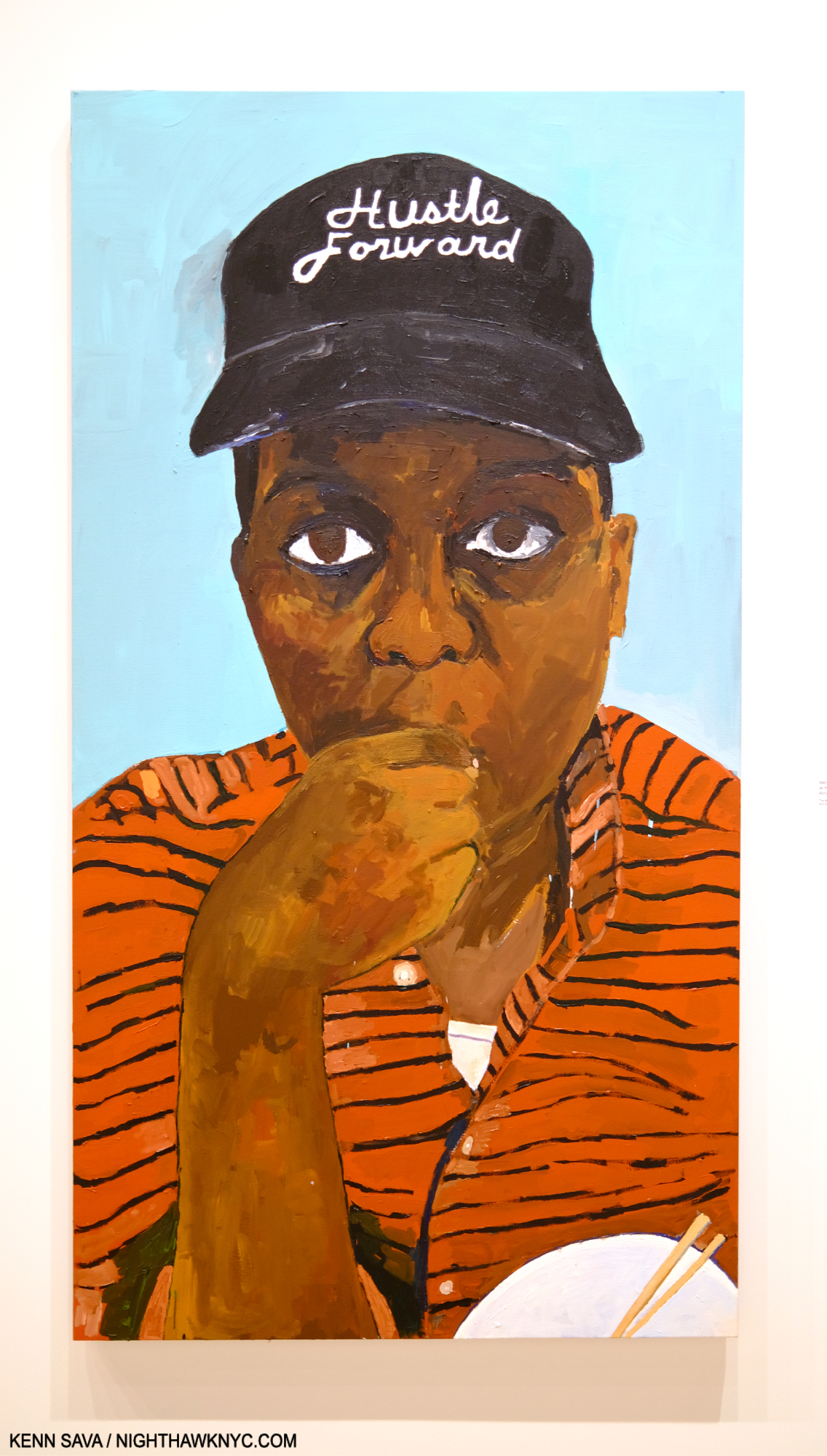
Man, I’m so full of doubt, but I must Hustle Forward, as my daughter Jade would say, 2020. Ladies & gentlemen, the one and only Henry Taylor.
It seems to me that to be able to face ALL of this with dignity and empathy for others is a remarkable thing; something all-too-rare today. As great as Henry Taylor’s Art is, this says even more about Henry Taylor, the man.
*- Soundtrack for this piece is “Sign O’ the Times” by Prince, performed live here in 1987, during Henry Taylor’s Camarillo days-
NighthawkNYC.com has been entirely self-funded & ad-free for over 8 1/2 years, during which 320 full-length pieces have been published! If you’ve found it worthwhile, PLEASE donate by PayPal to allow me to continue below. Thank you, Kenn.
You can also support it by buying Art, Art & Photography books, and Music from my collection! Art & Books may be found here. Music here and here.
Written & photographed by Kenn Sava for nighthawknyc.com unless otherwise credited. To send comments, thoughts, feedback or propositions click here. Click the white box on the upper right for the archives or to search them. Subscribe to be notified of new Posts below. Your information will be used for no other purpose.
- Antwaun Sargent on Artsy in 2018 ↩
- Antwaun Sargent on Artsy in 2018 ↩
- Where Charlie Parker was famously sent for six months in 1946, and supposedly immortalized it in “Relaxin’ at Camarillo,” though he hated that title his producer gave it. It’s also rumored to be euphemistically referred to as “Hotel California” in the Eagles song of the same name. ↩
- Henry Taylor: B Side Catalog, P.60 ↩

